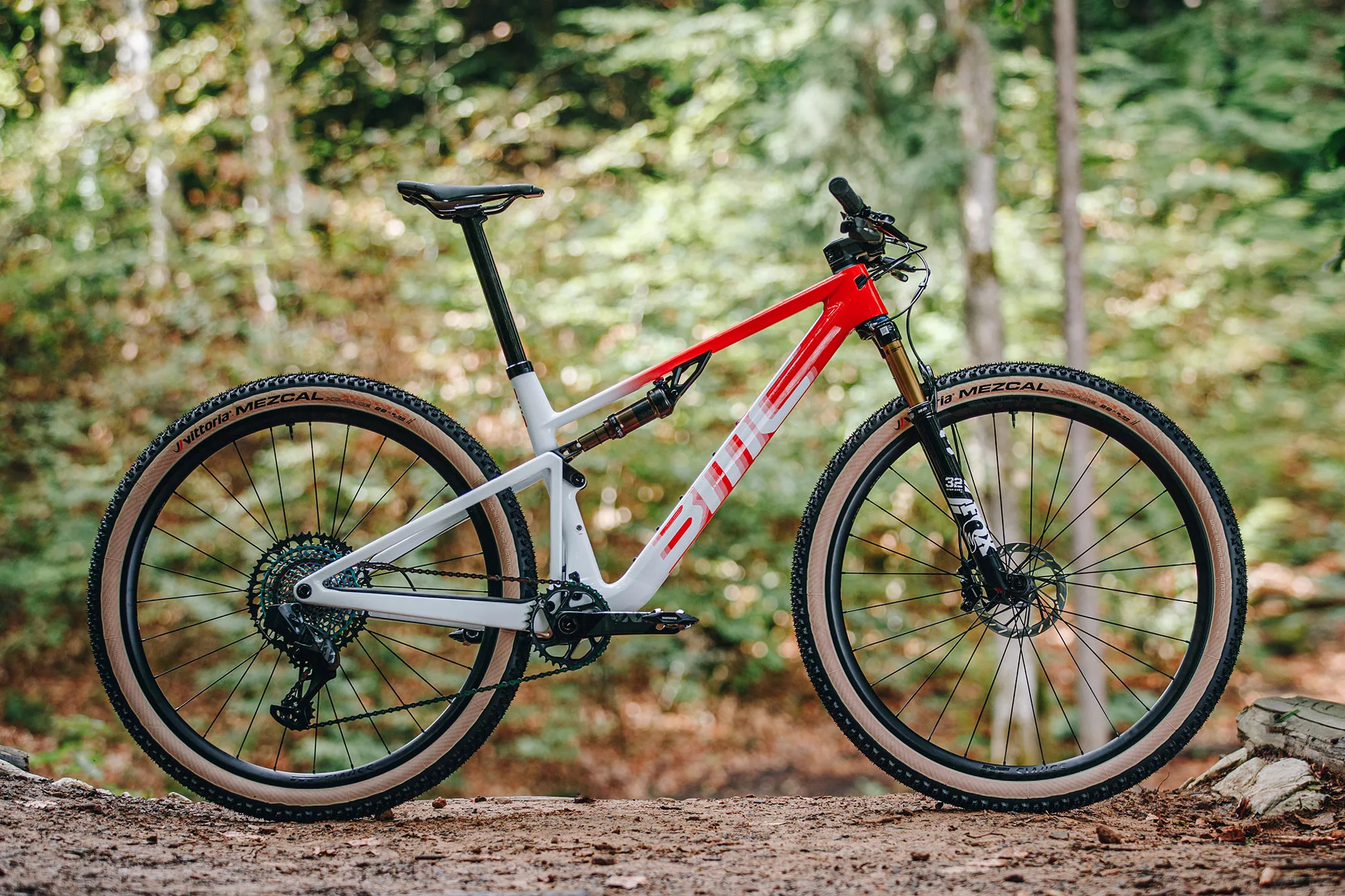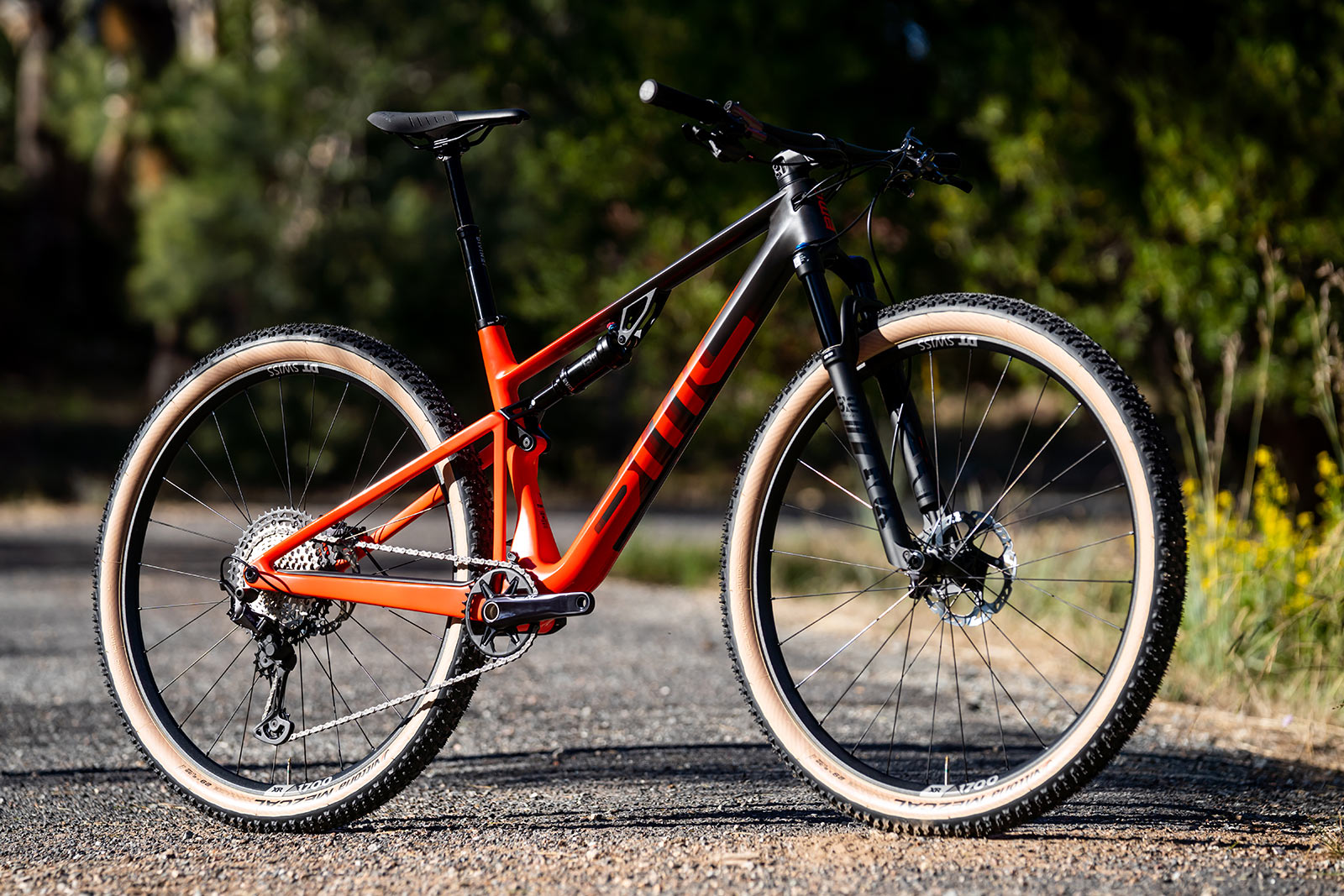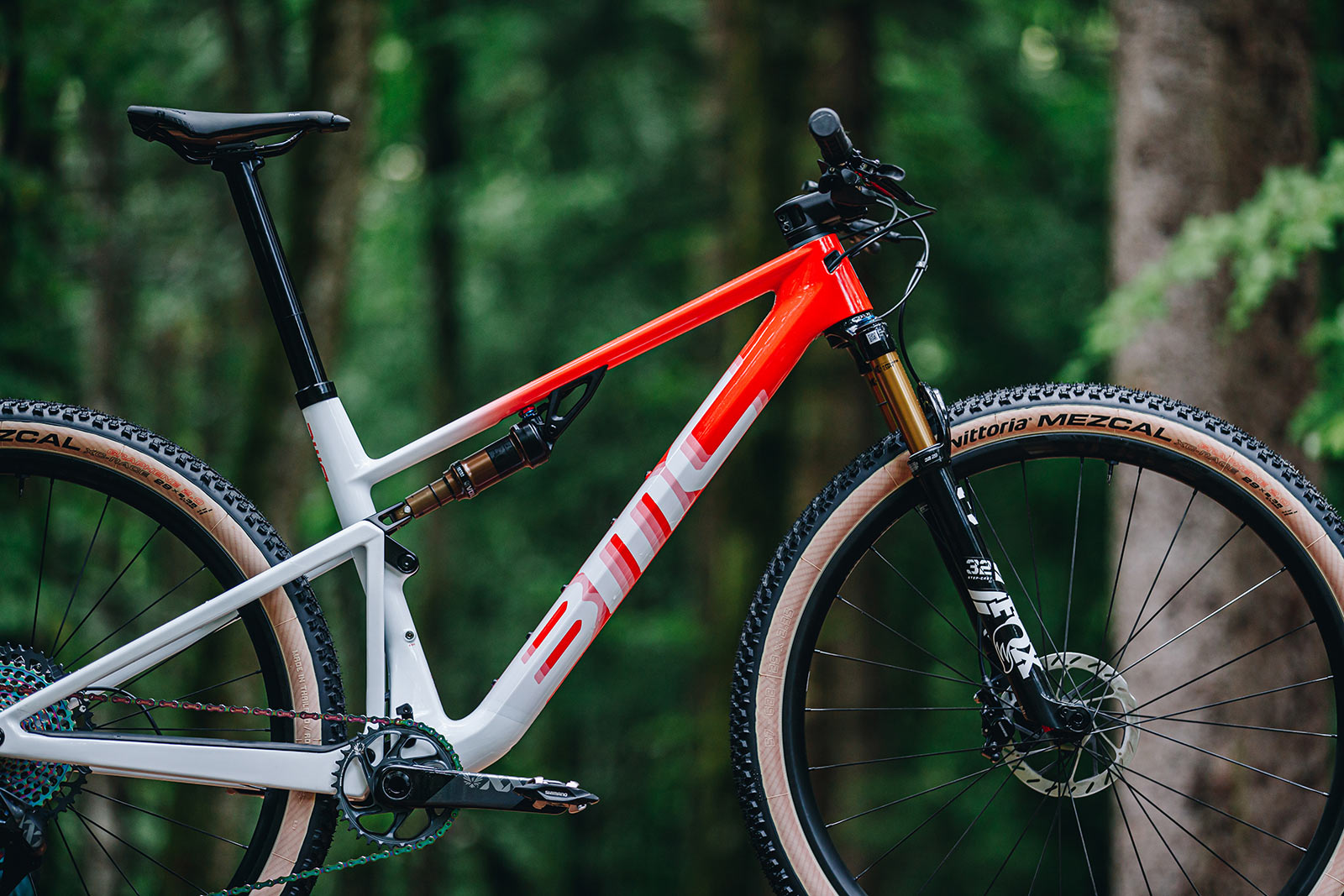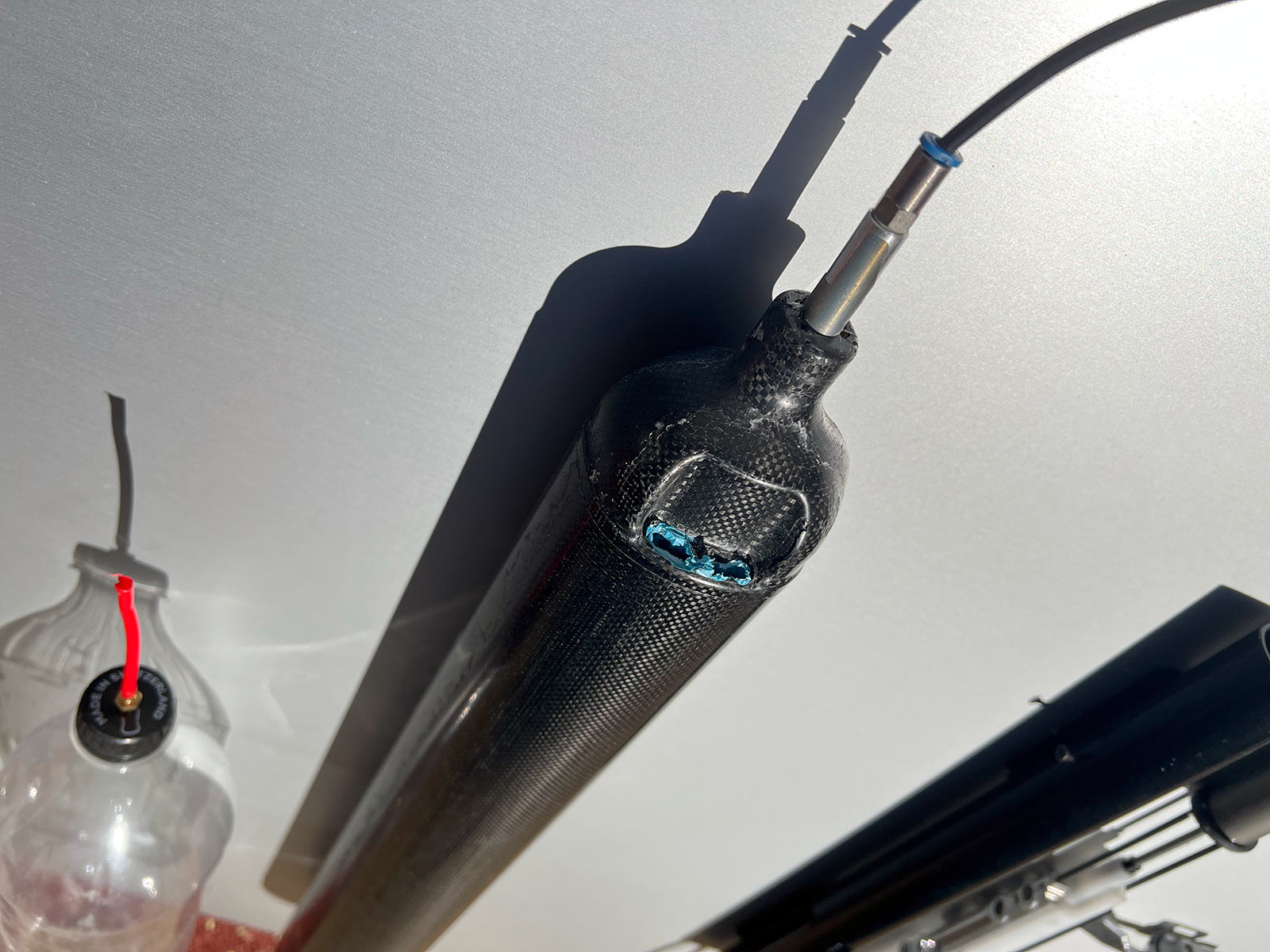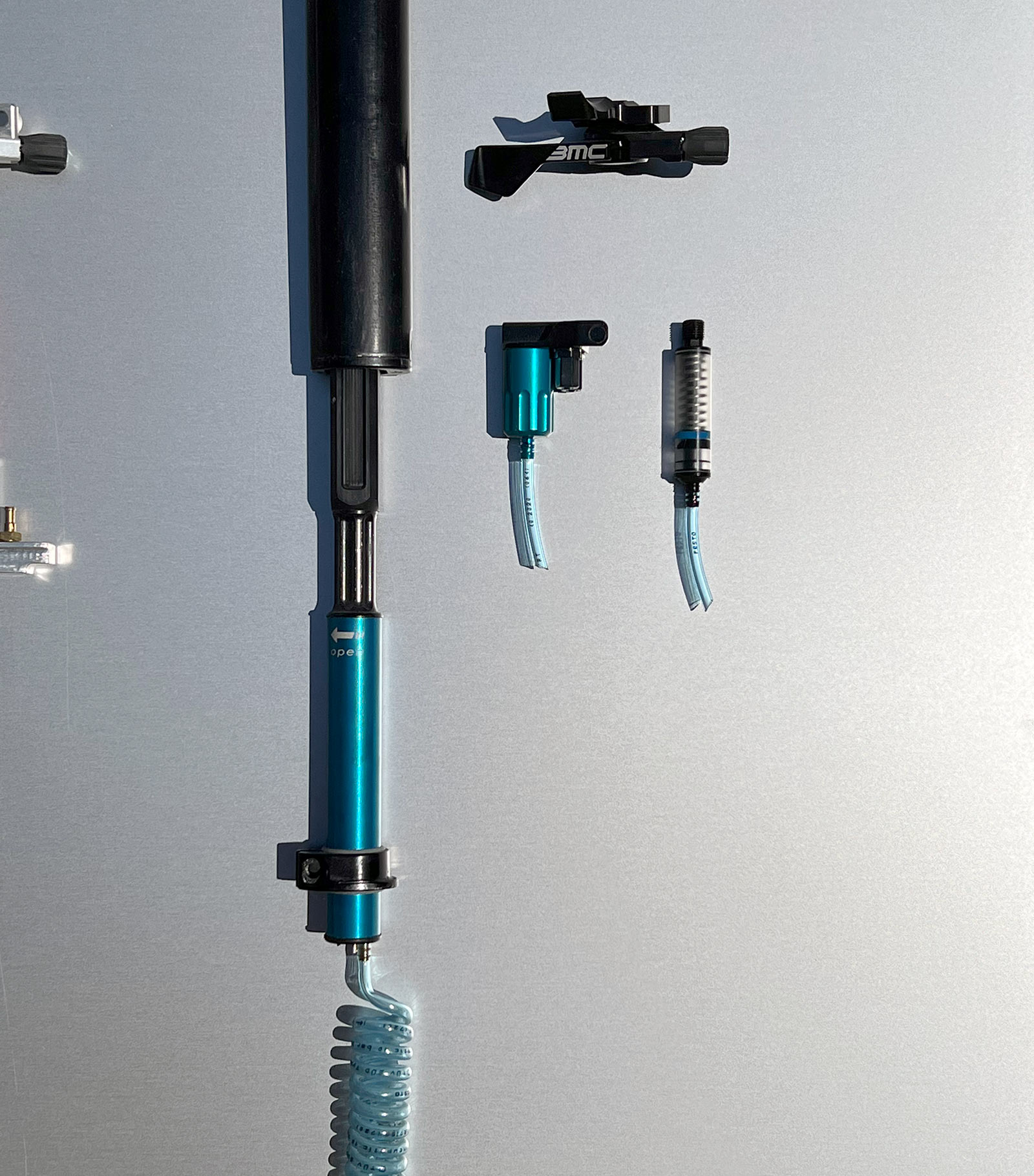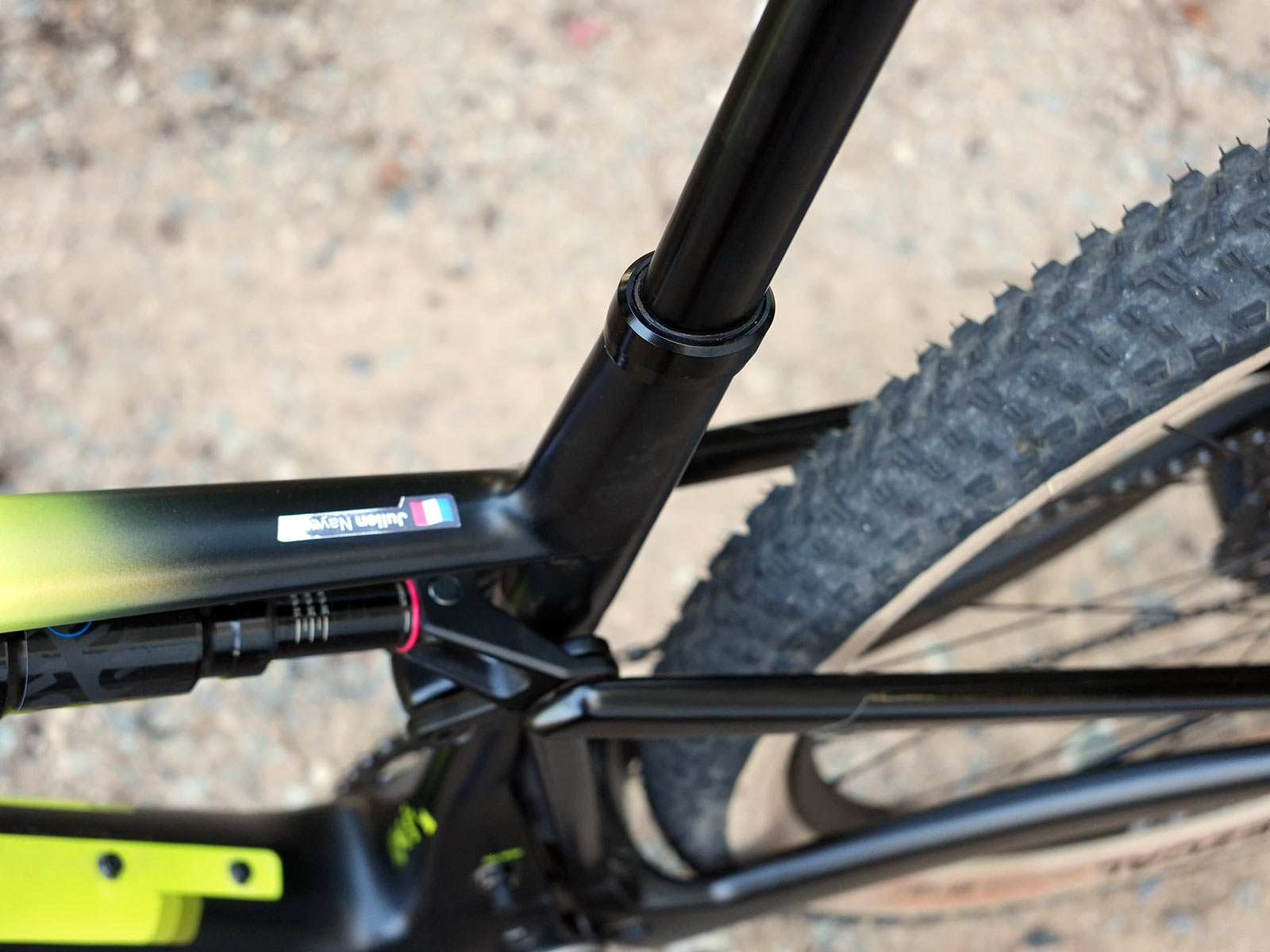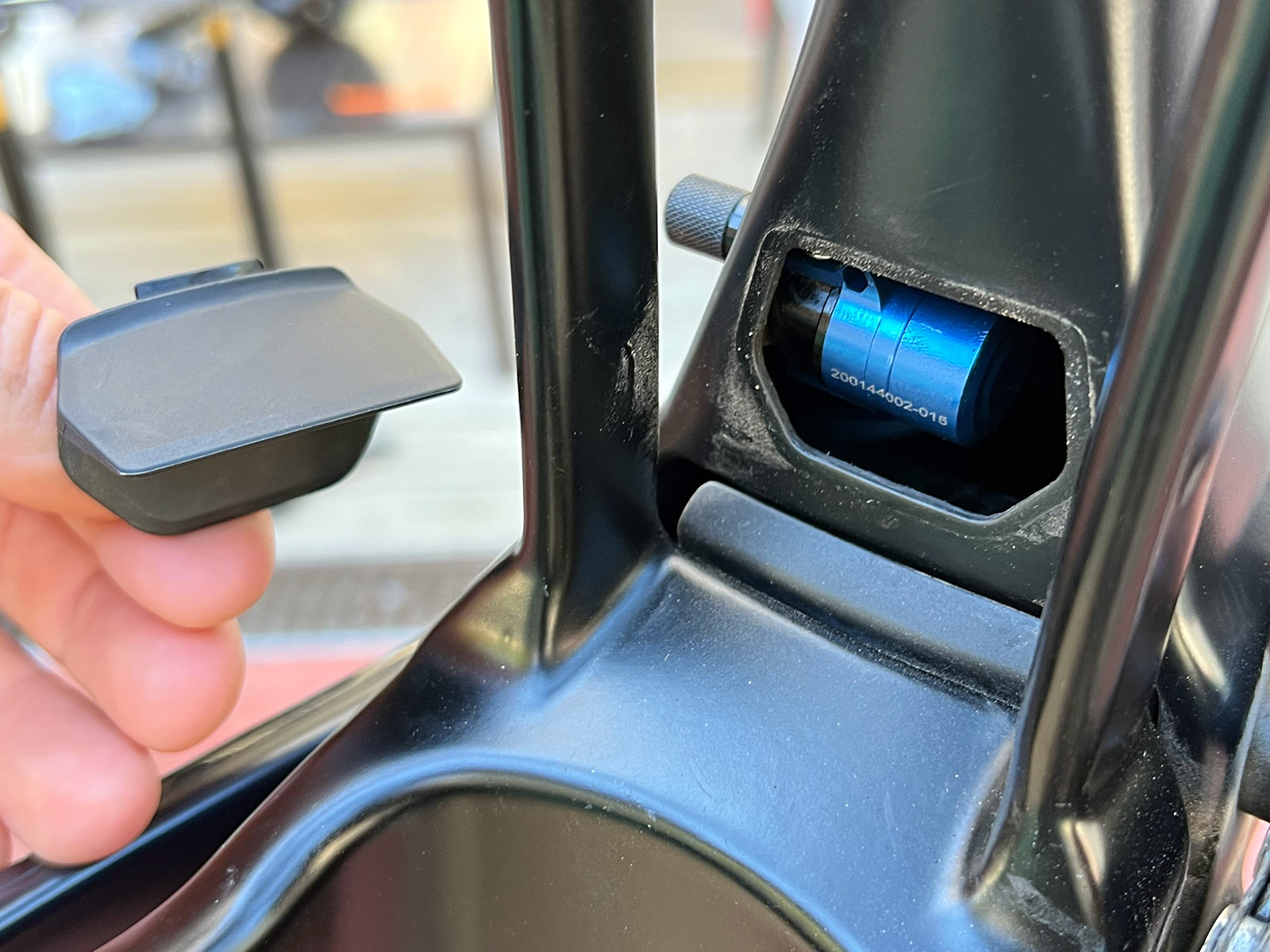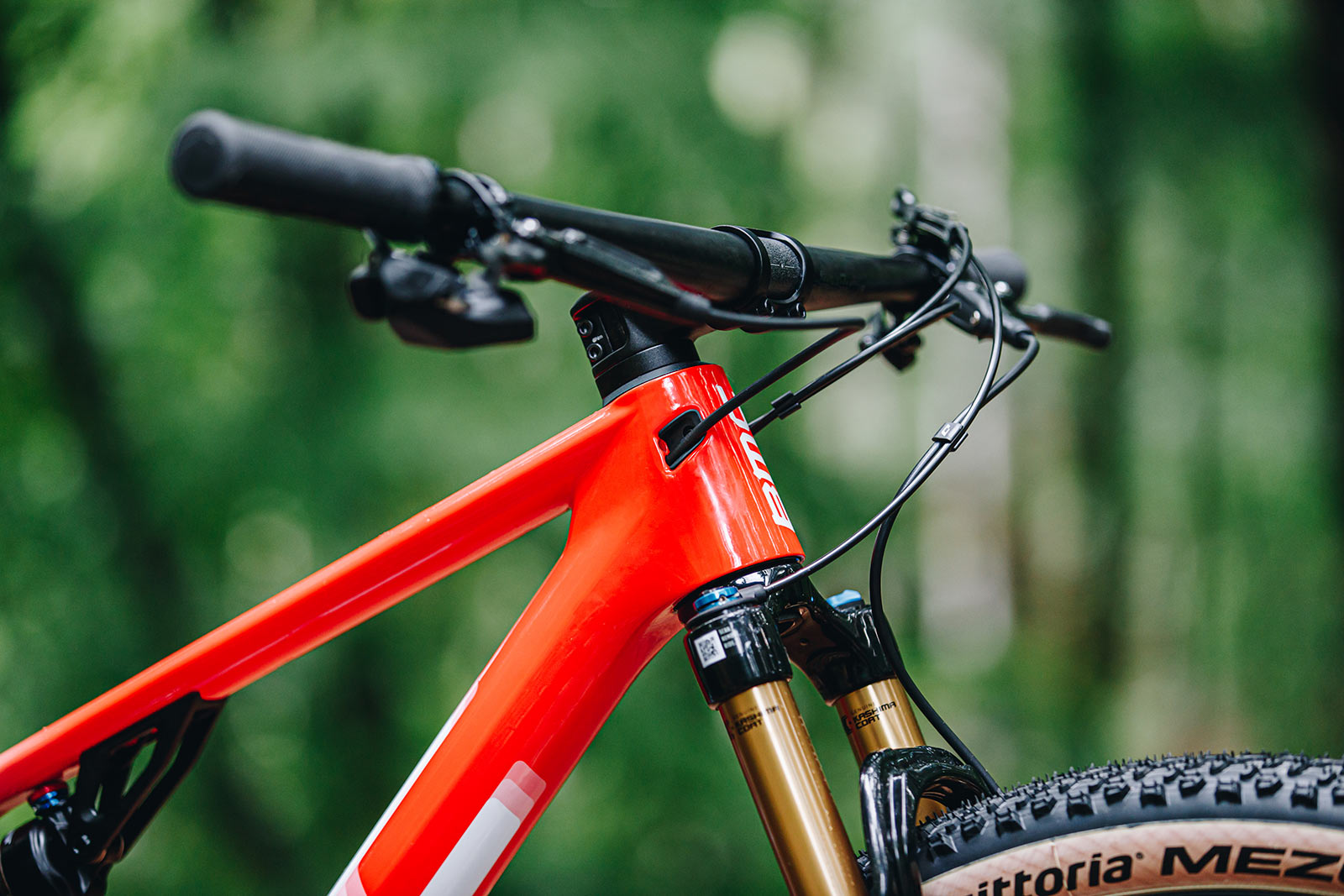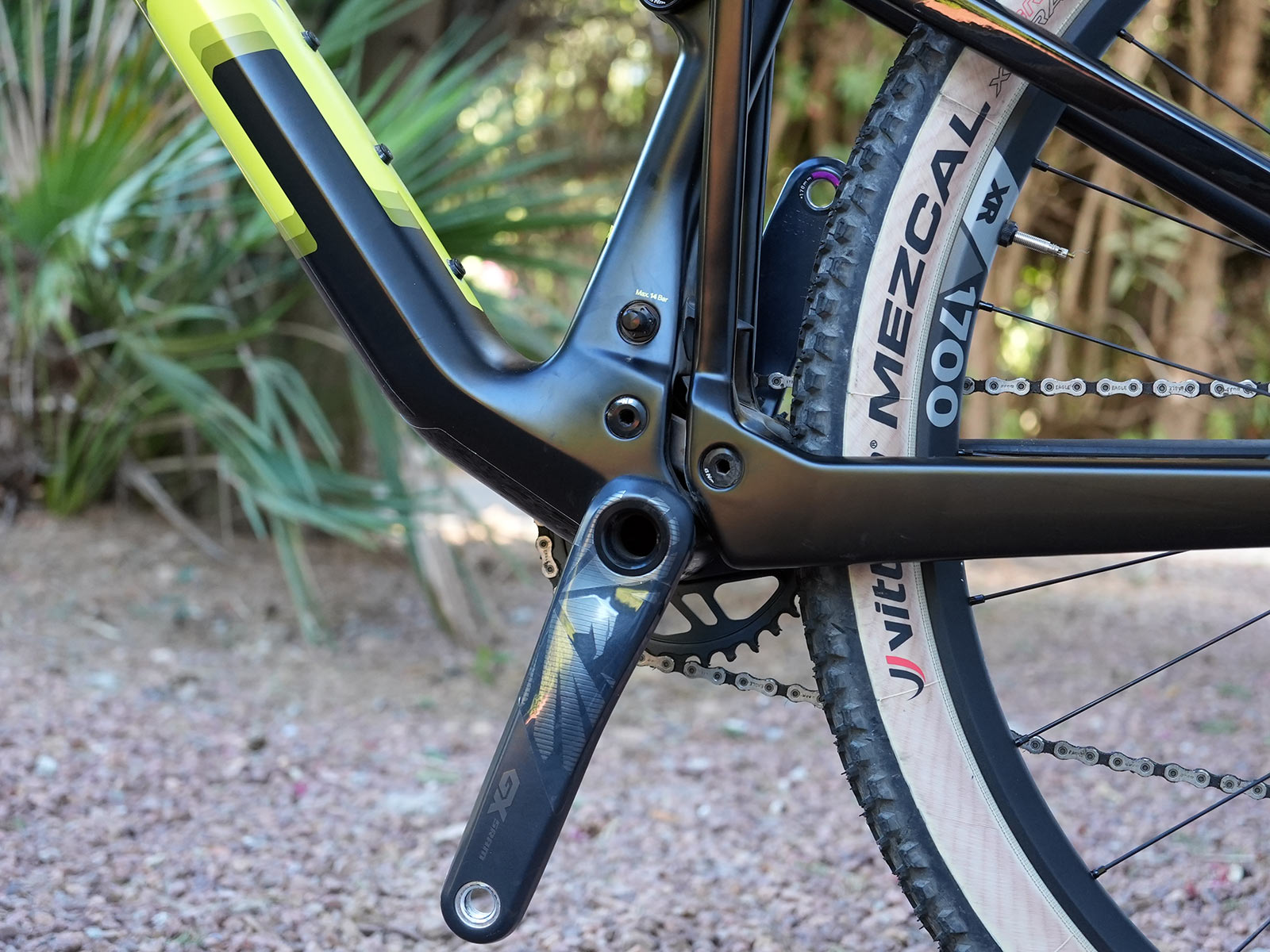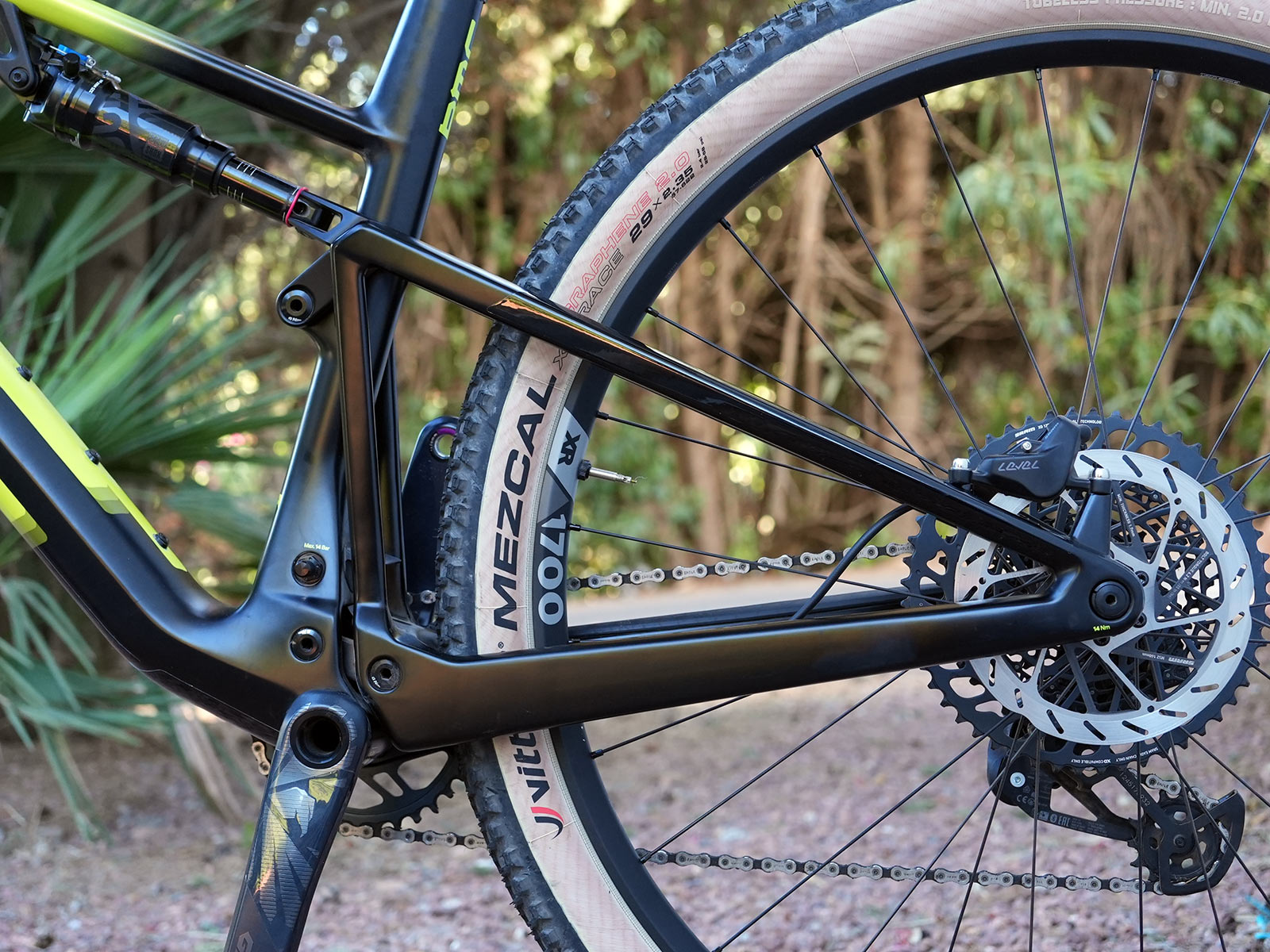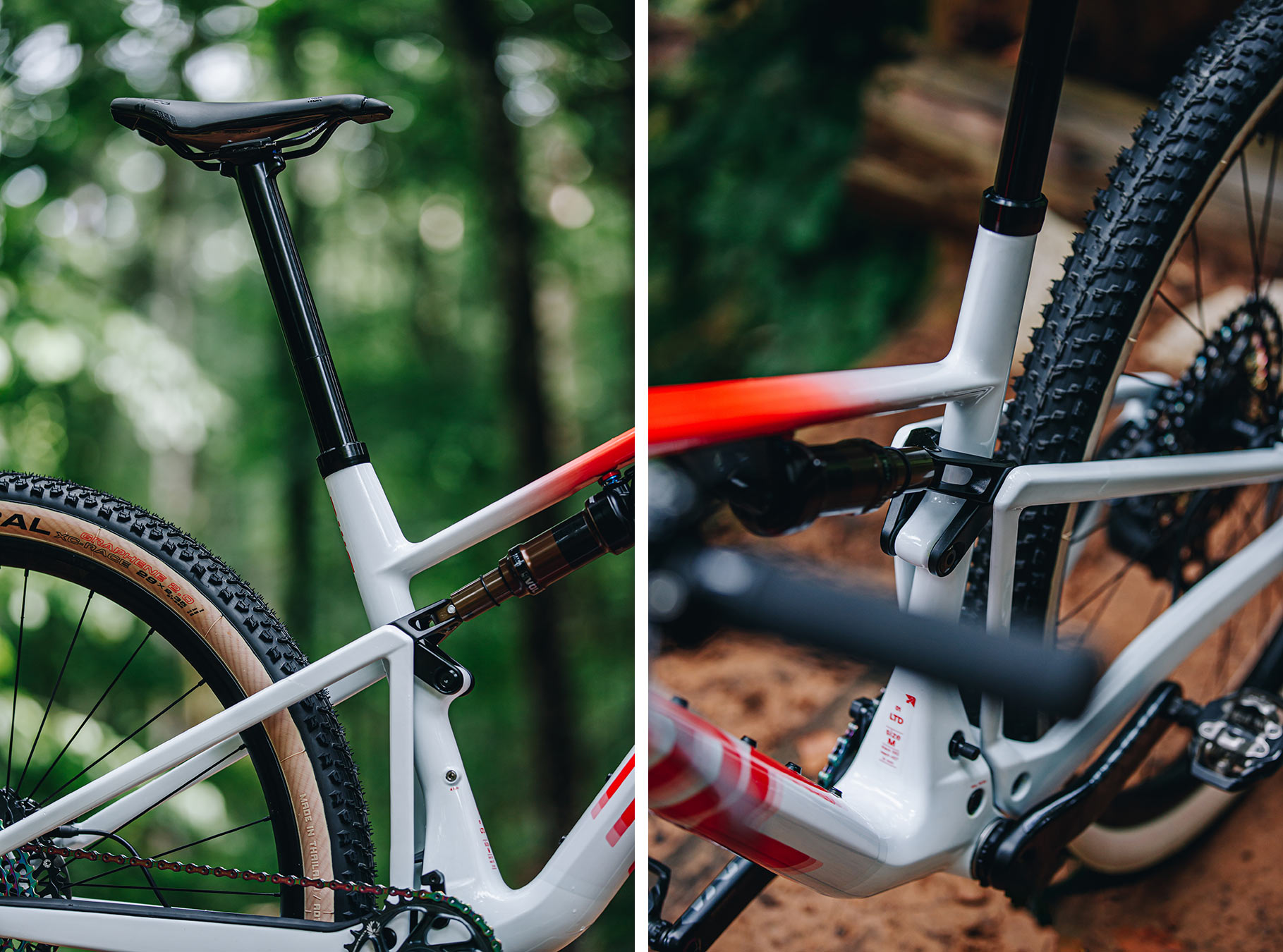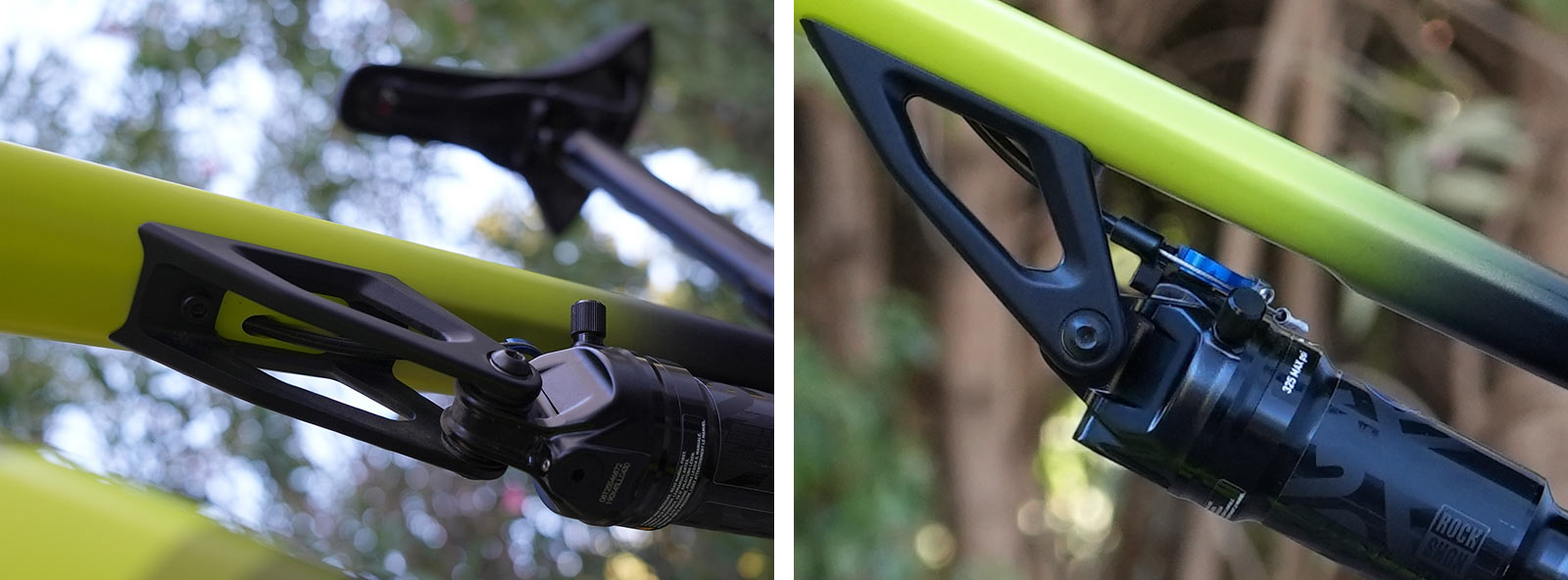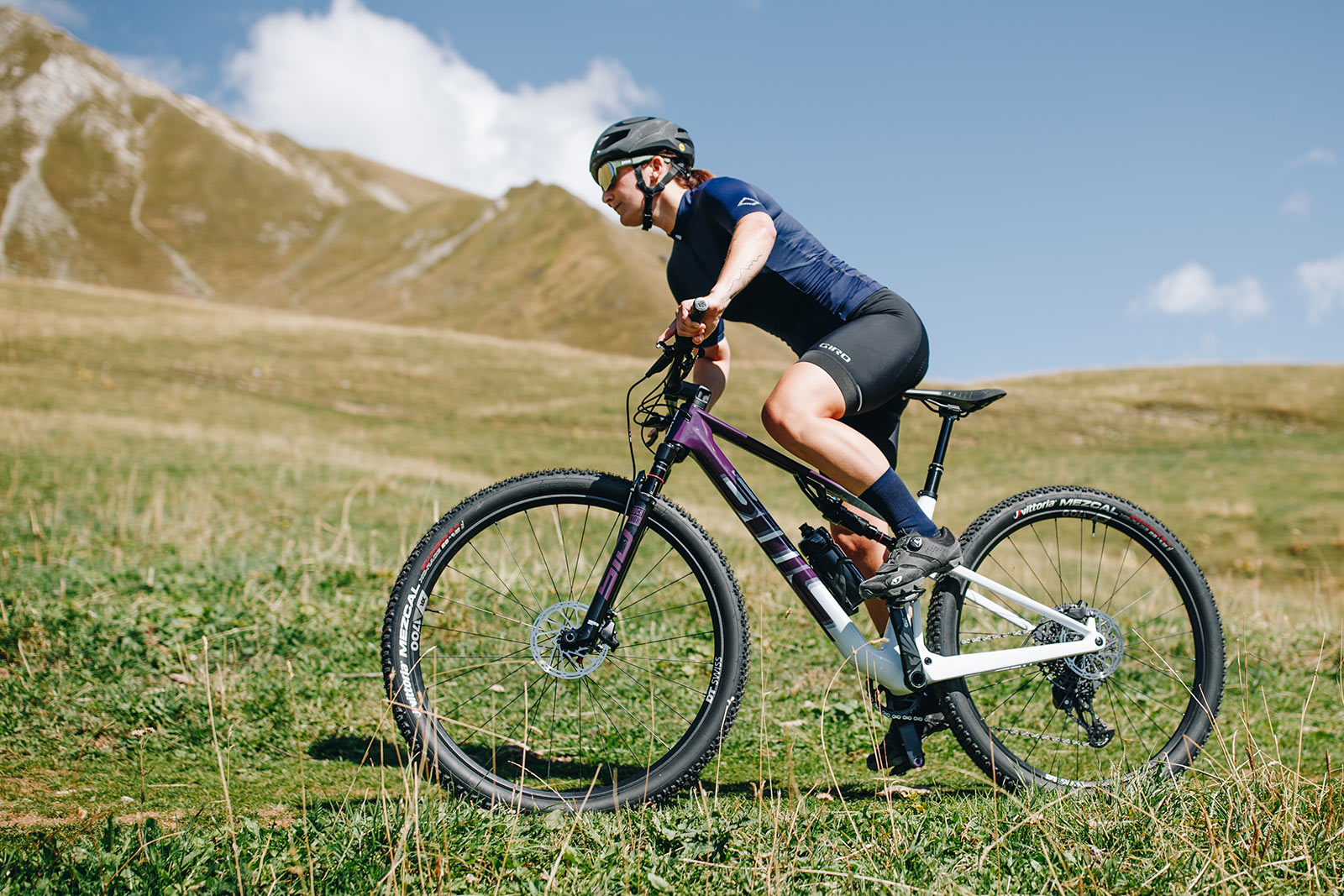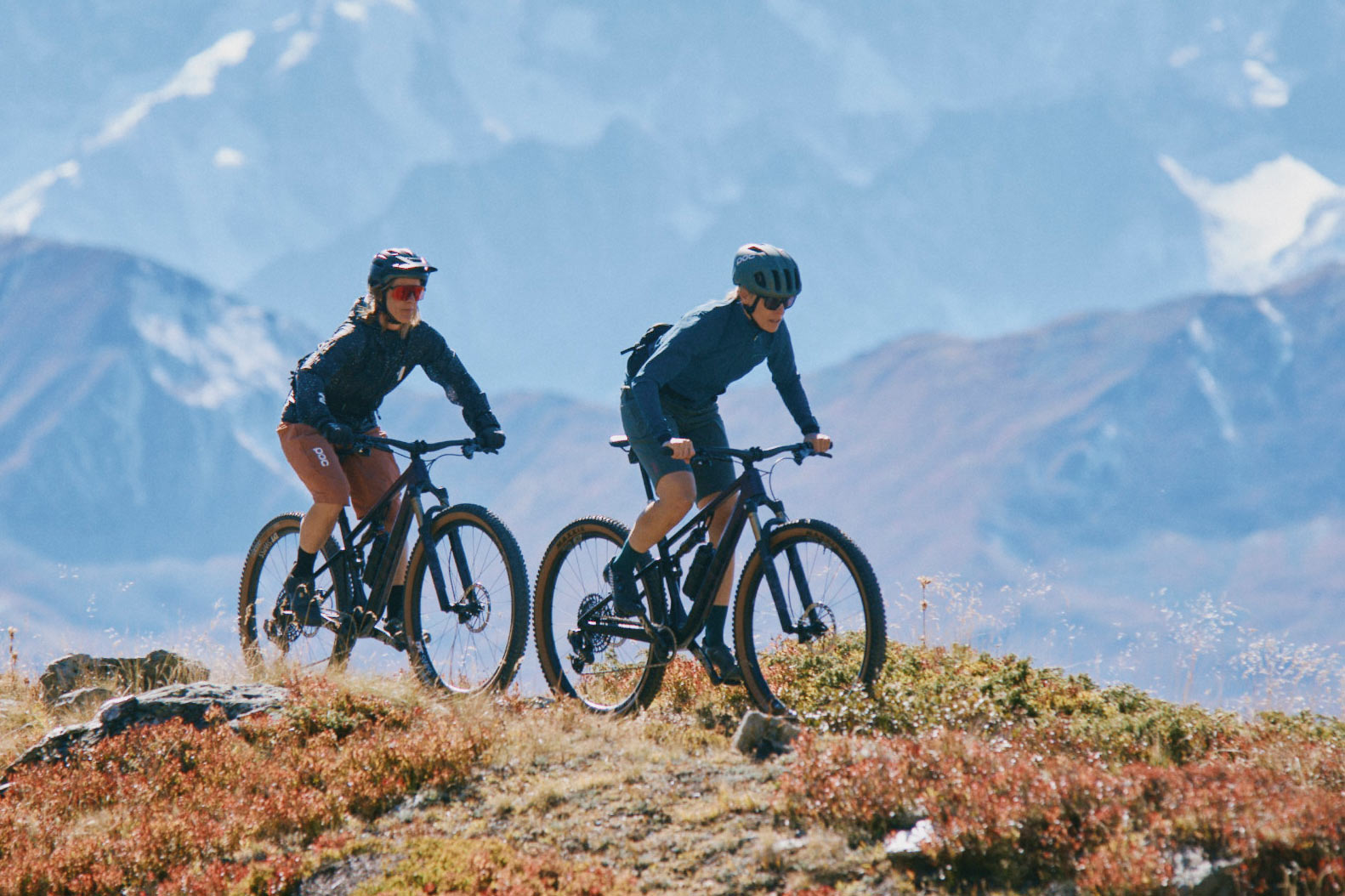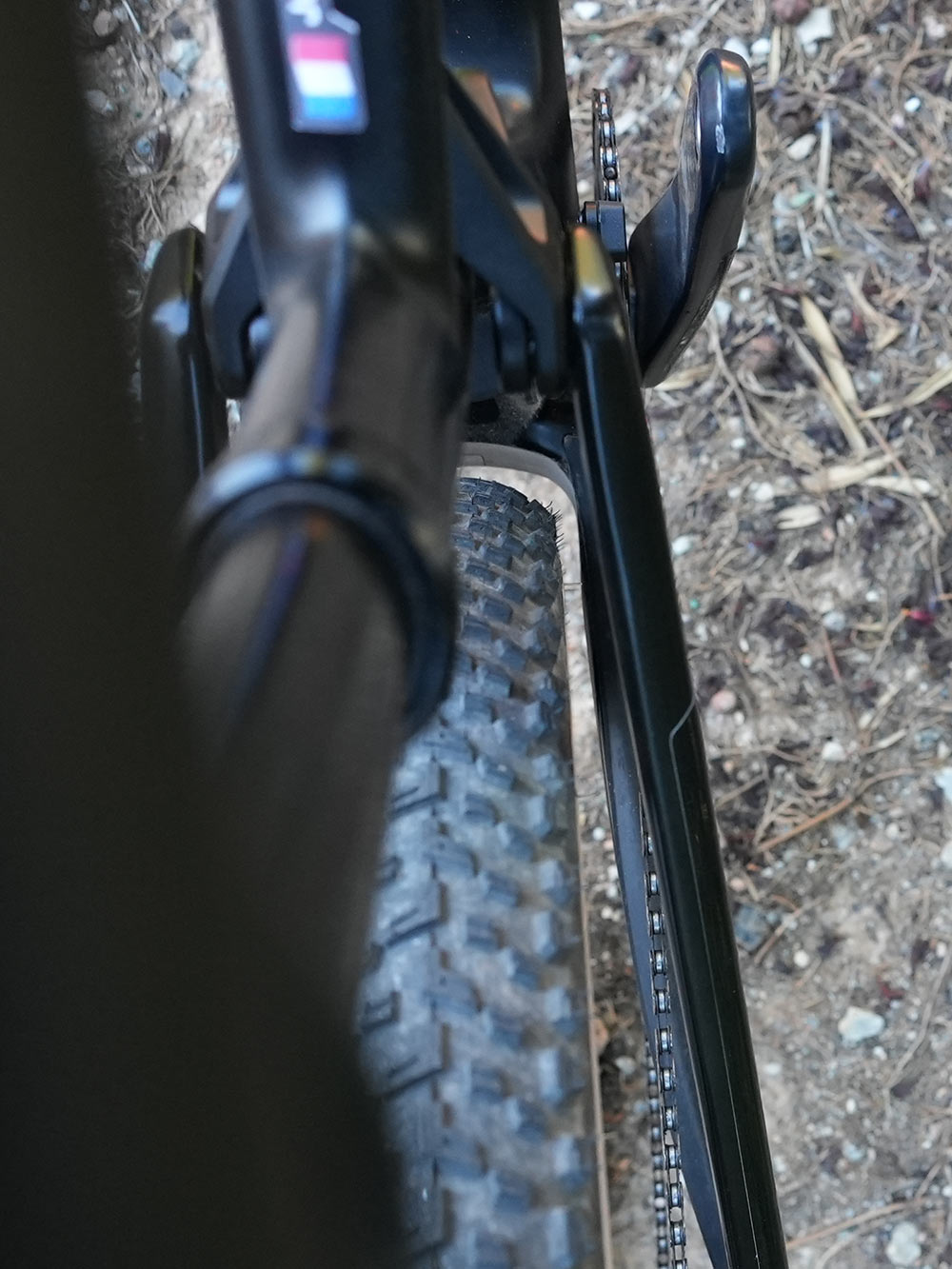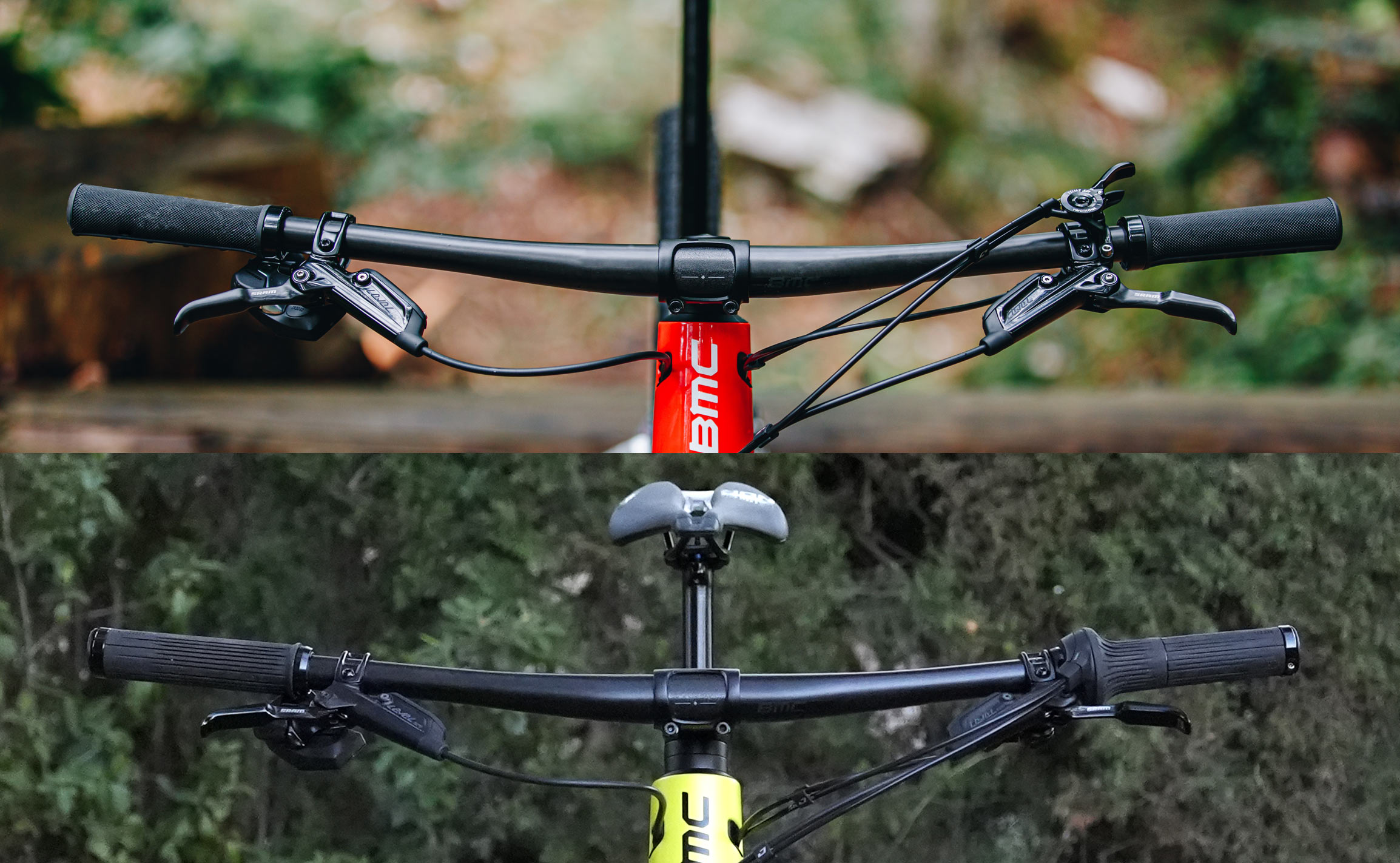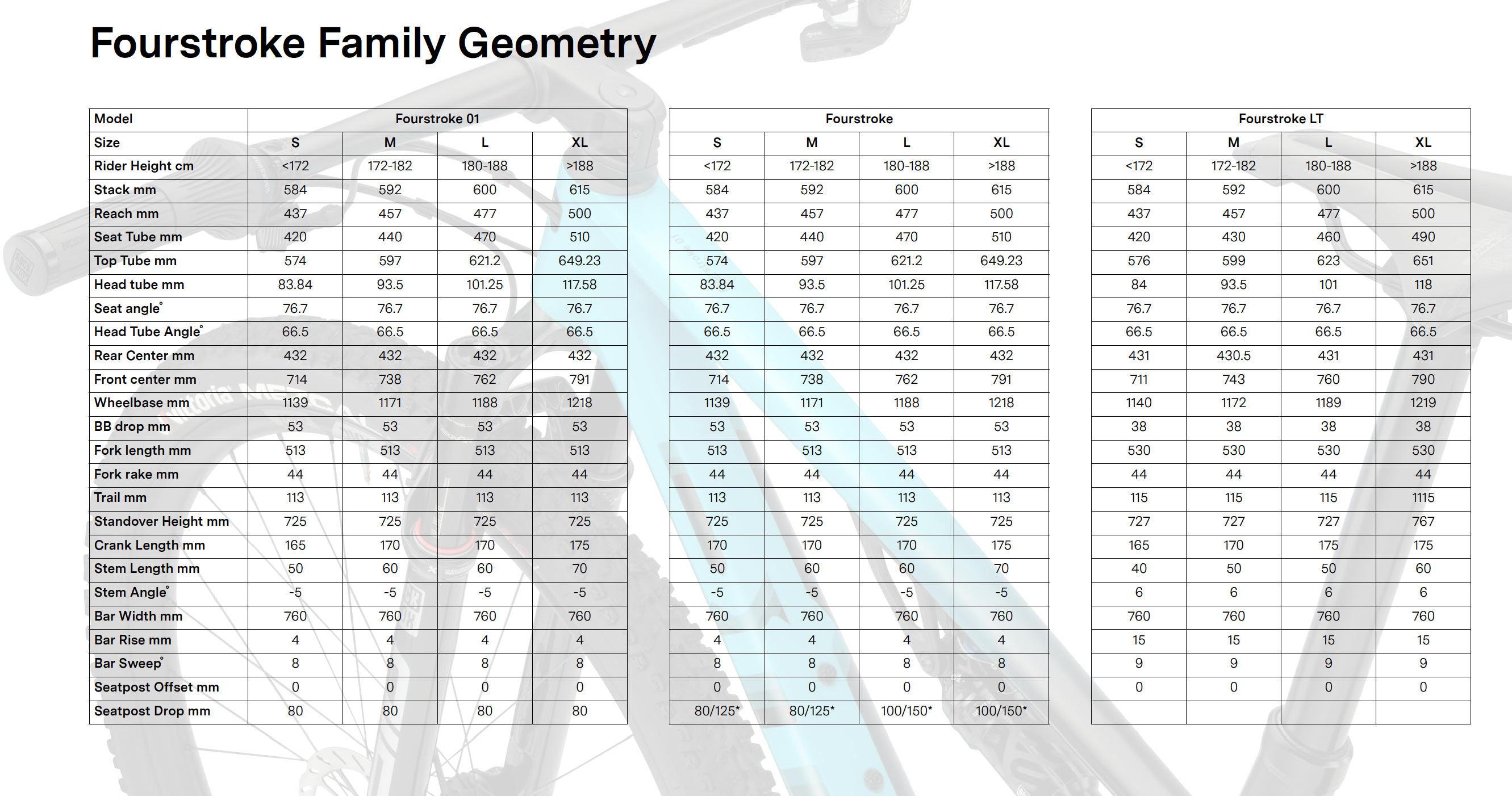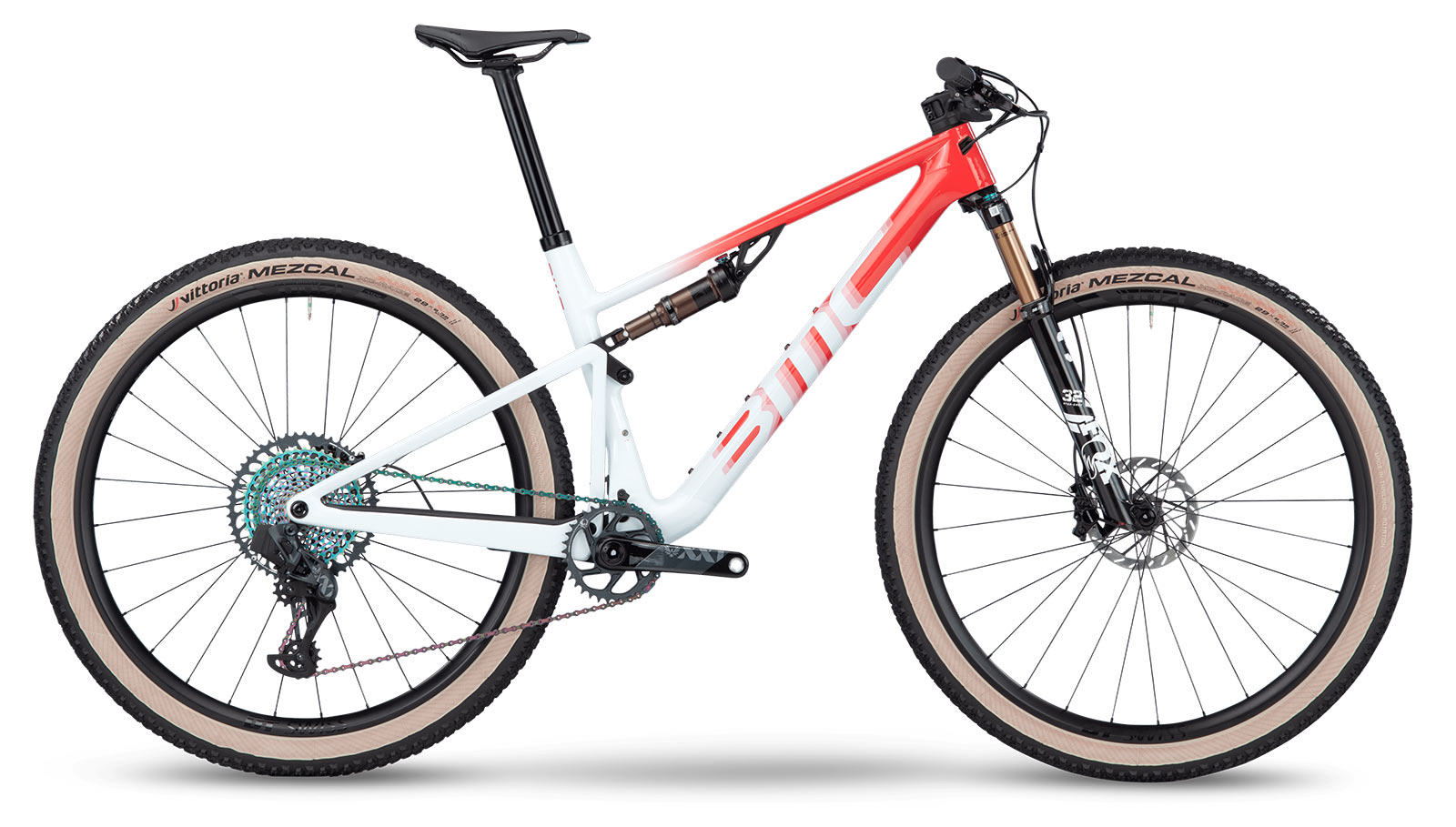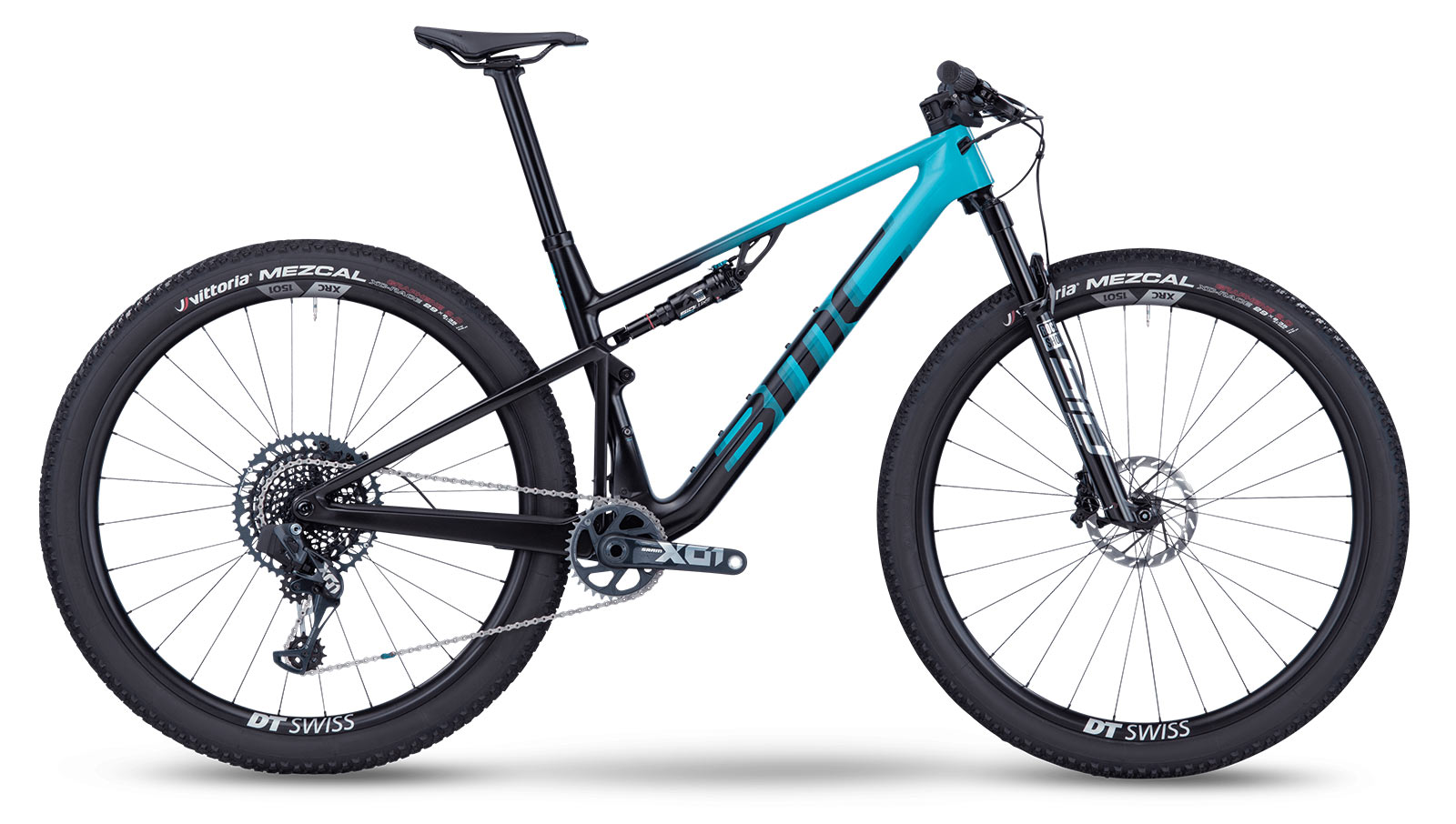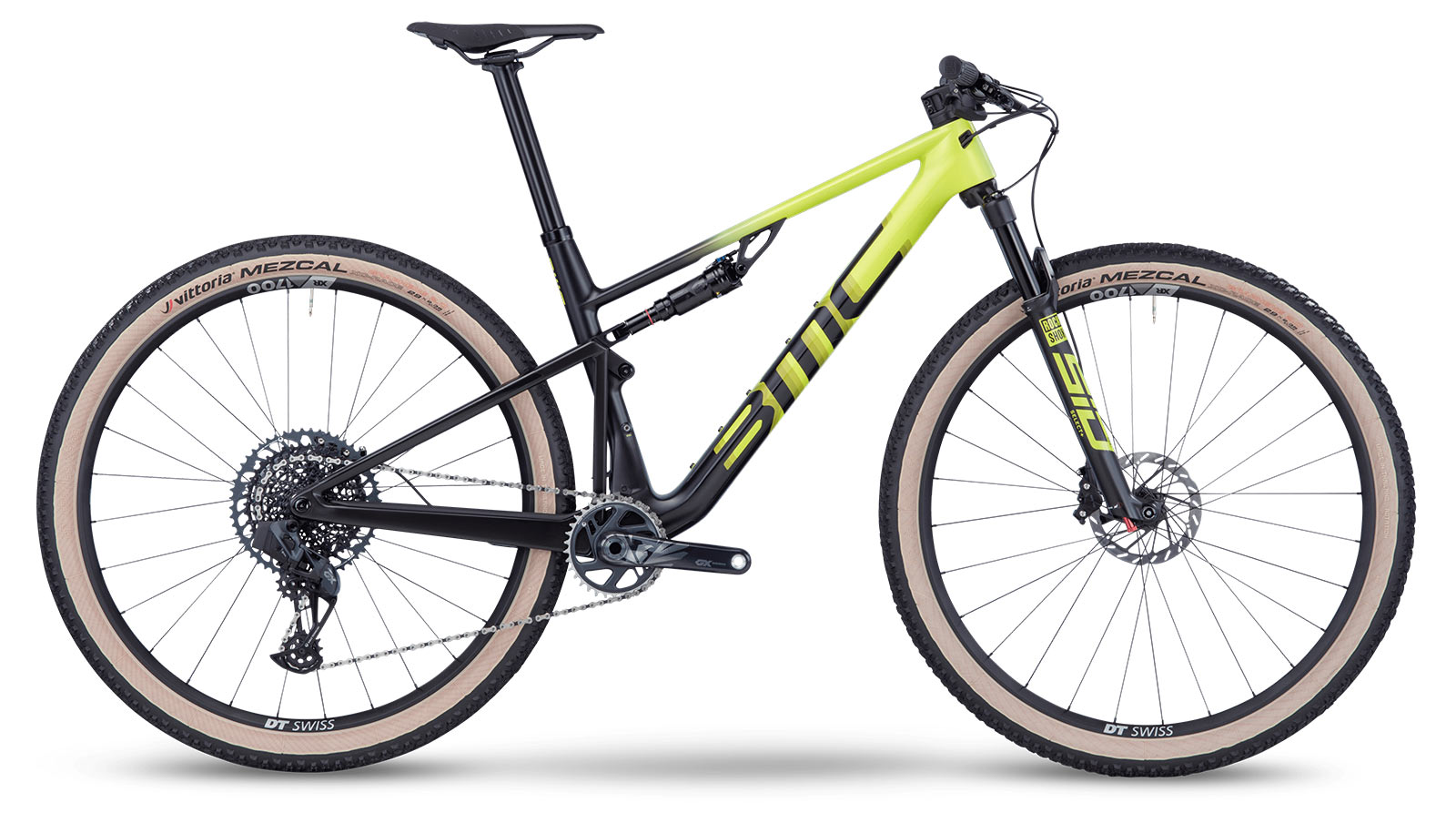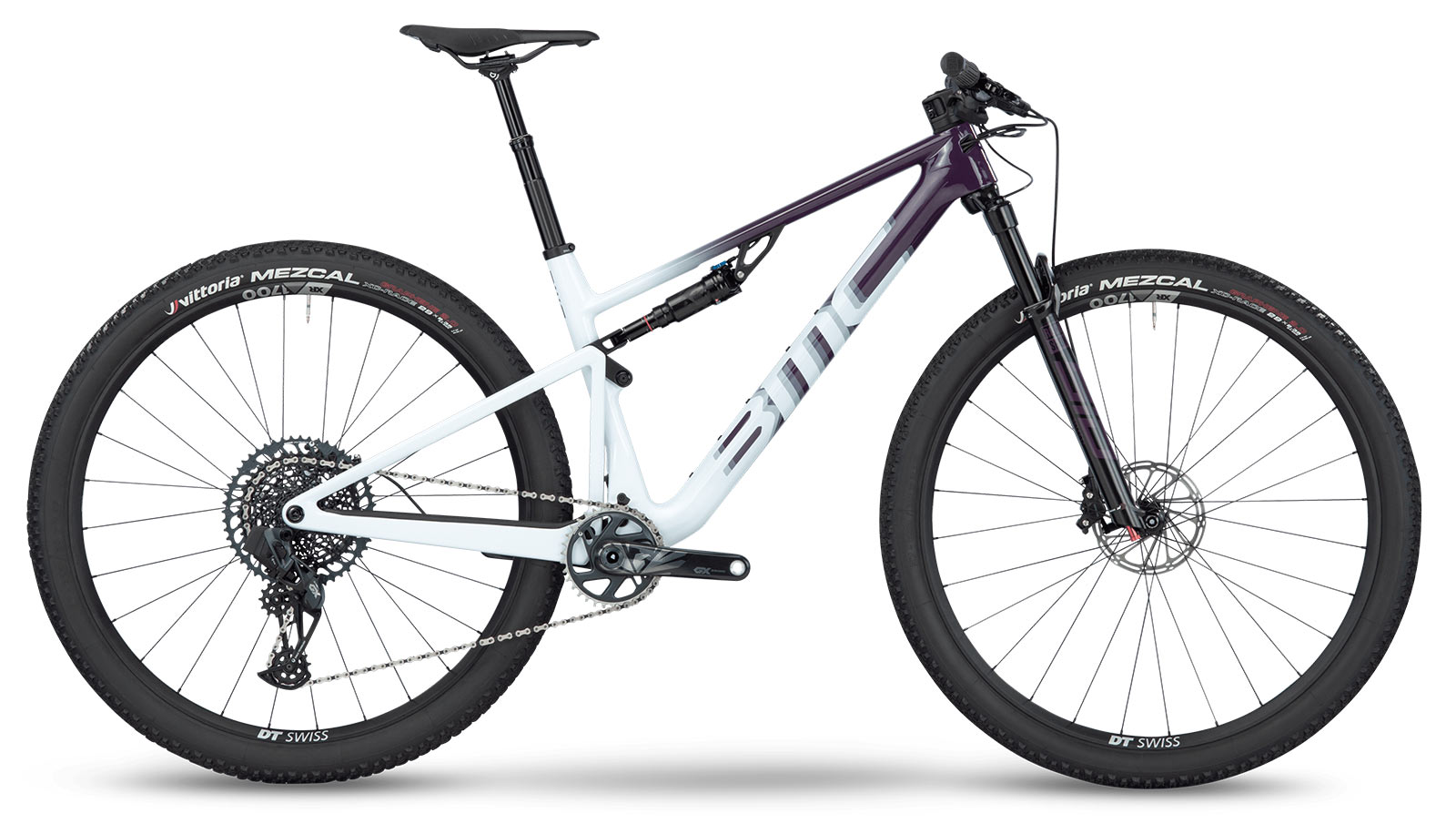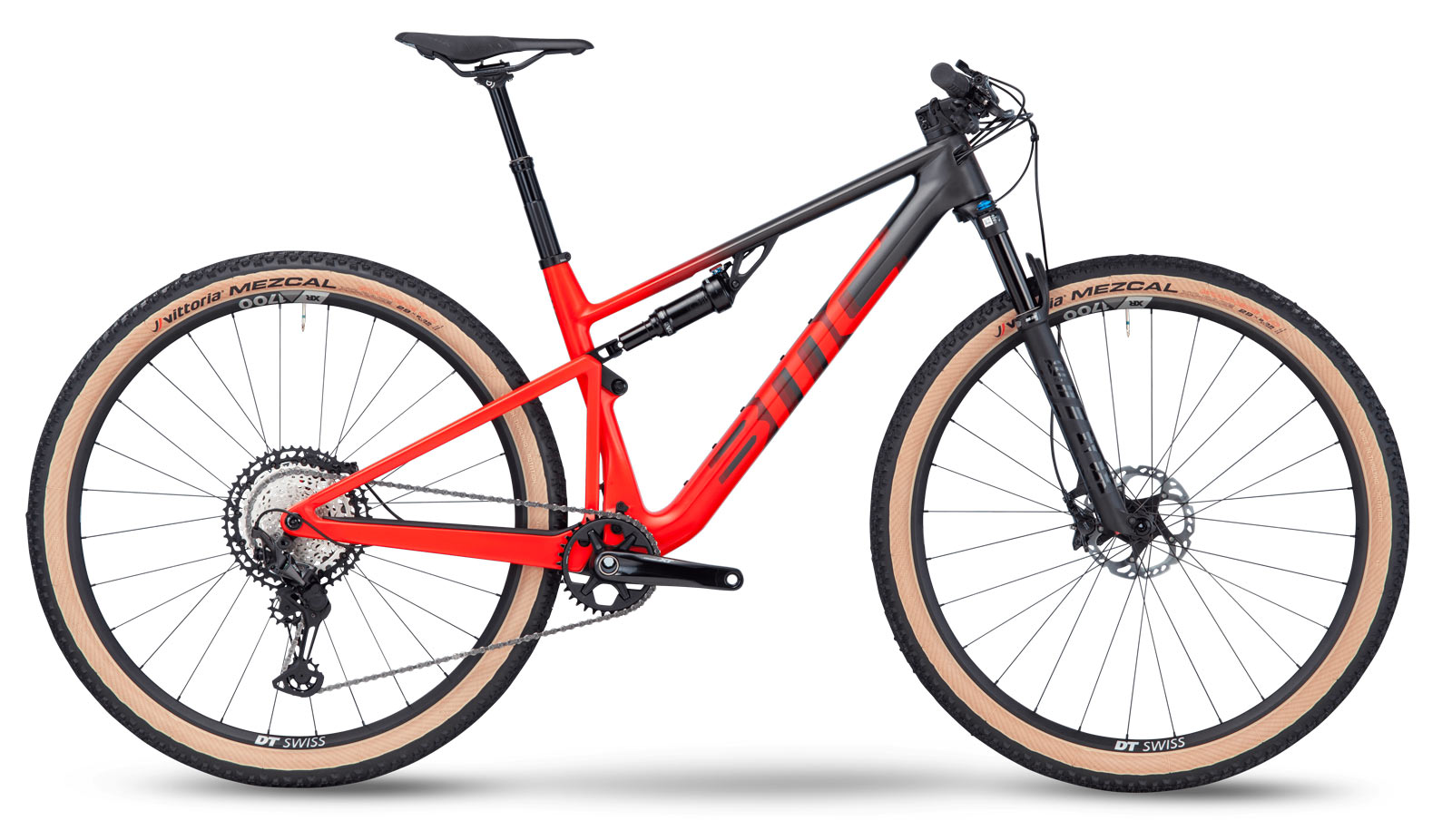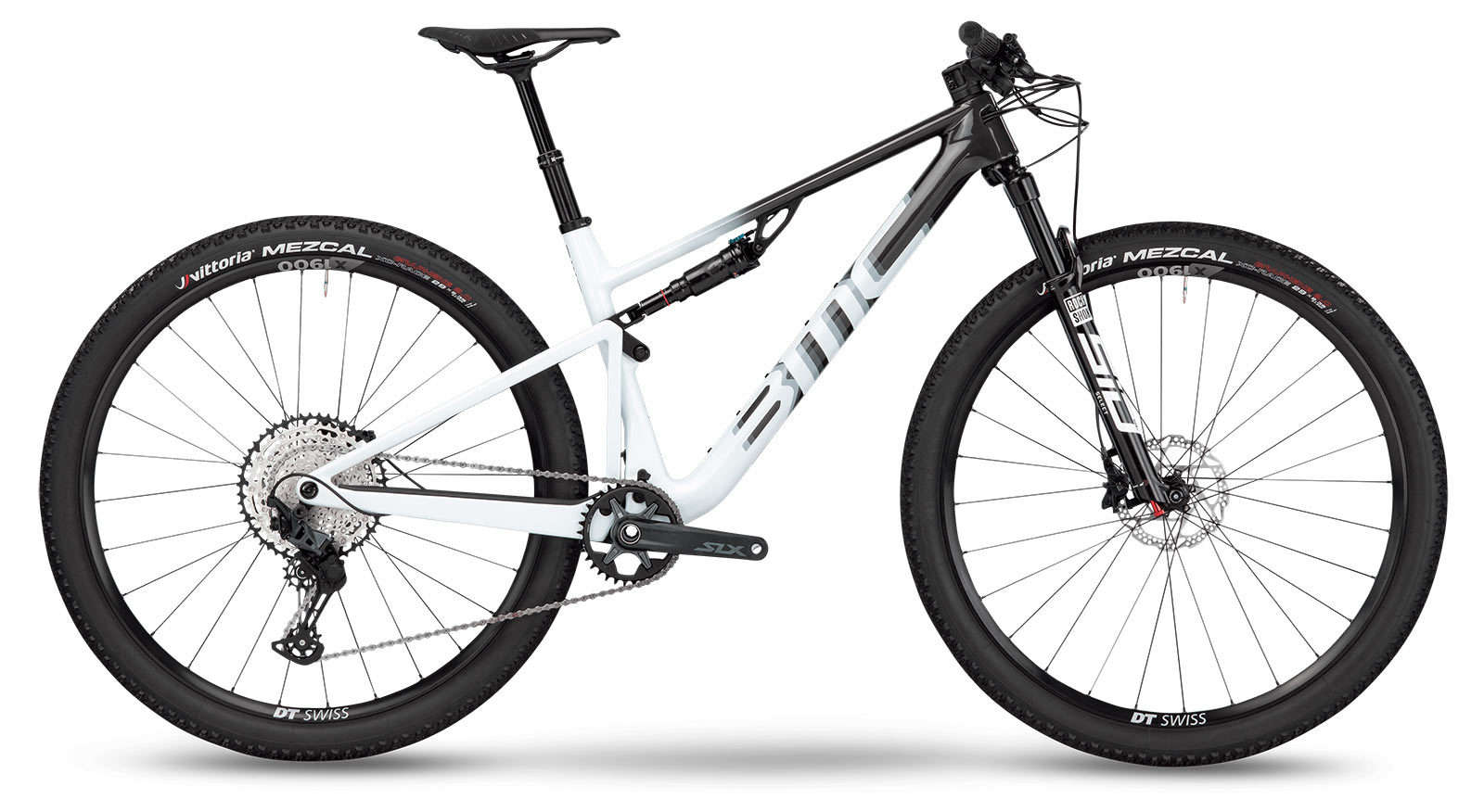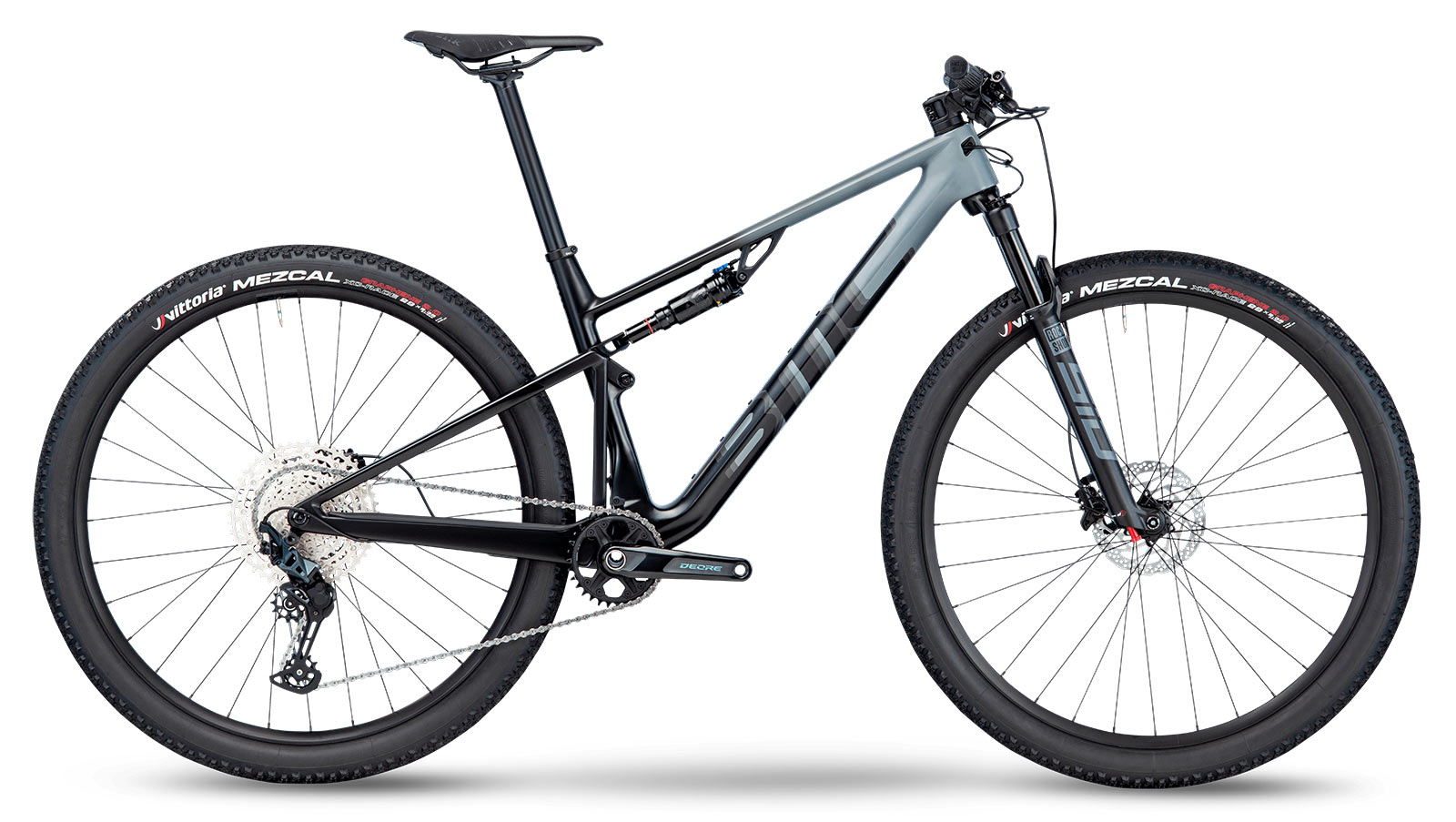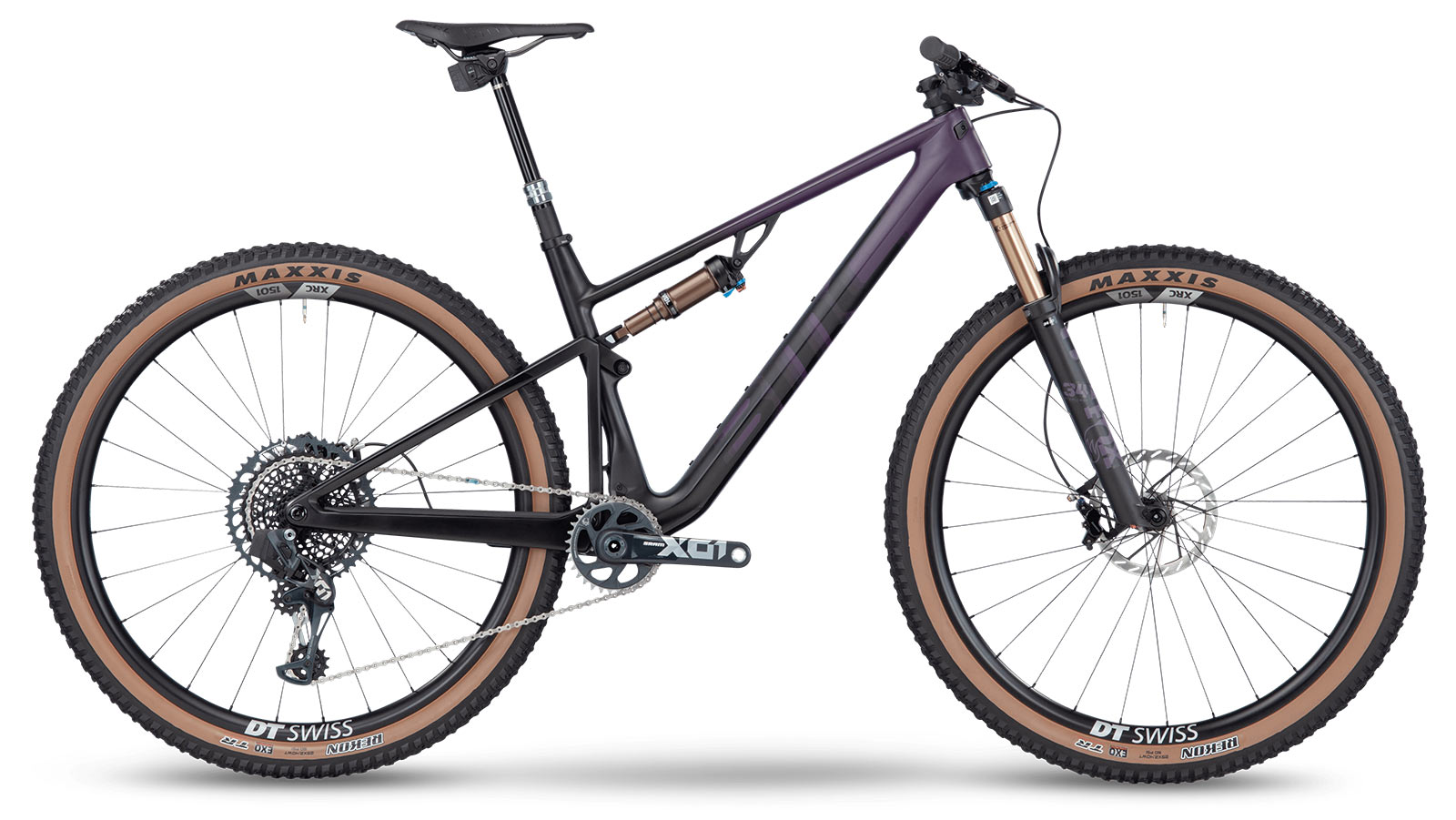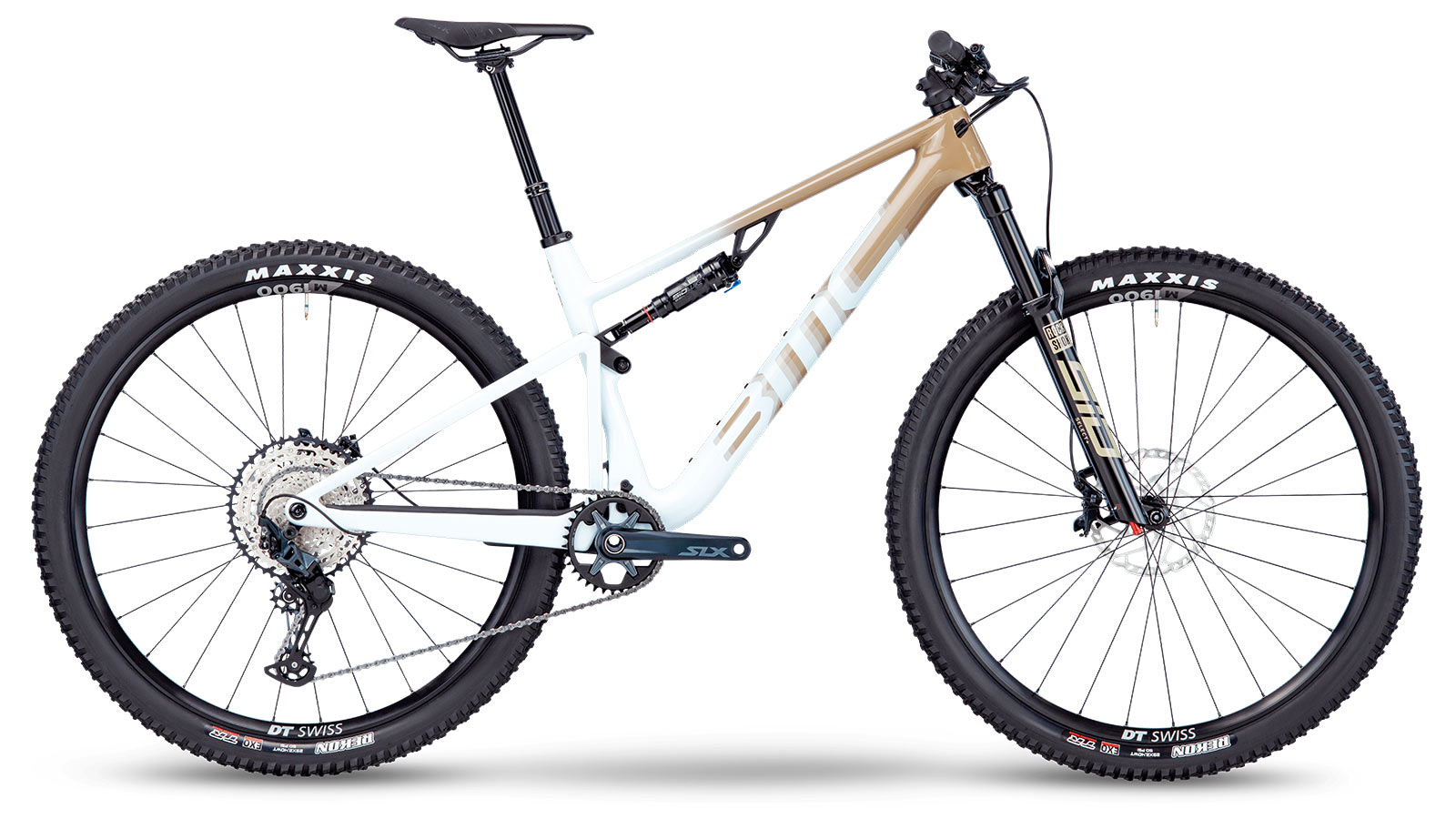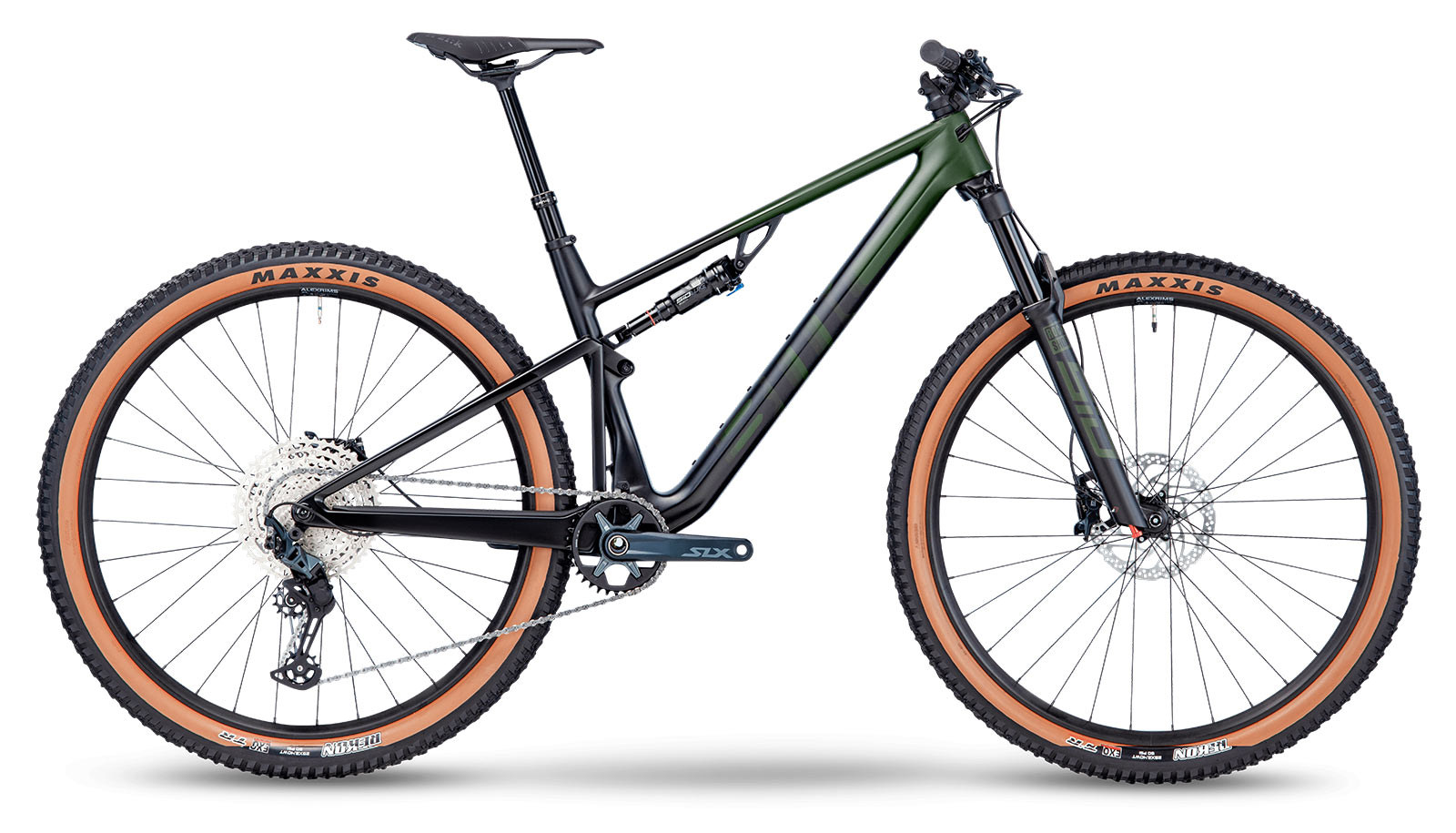The new BMC Fourstroke family of cross country bikes isn’t just one bike, it’s three analog bikes, from a World Cup-winning pure XC race machine to a proper trail bike, with an affordable XC model sitting between them, plus a fourth model to yet to come.
The headliner is the Fourstroke 01, with 100mm travel front and rear and an amazing new Autodrop integrated dropper post that both raises and lowers at the press of a lever. Below that are the standard Fourstroke (100mm travel) and the Fourstroke LT (120mm), which use standard dropper posts and lower grade carbon, but share the same geometry.
The goal with the new range was to carry forward the innovation introduced with the 2018 models, but improve their capabilities for modern riders. For racers, that meant maximizing efficiency. For trail riders, the new Fourstroke LT becomes more user-friendly, better geo, and longer dropper travel.
The prior Fourstroke XC bike was progressive for the time, with a 67.5º head angle, and introduced an integrated dropper post that was not only unique for putting a dropper on an XC race bike, but also for being integrated into the frame. It was also one of the first full suspension bikes making regular rounds (and notching wins) on the World Cup circuit.
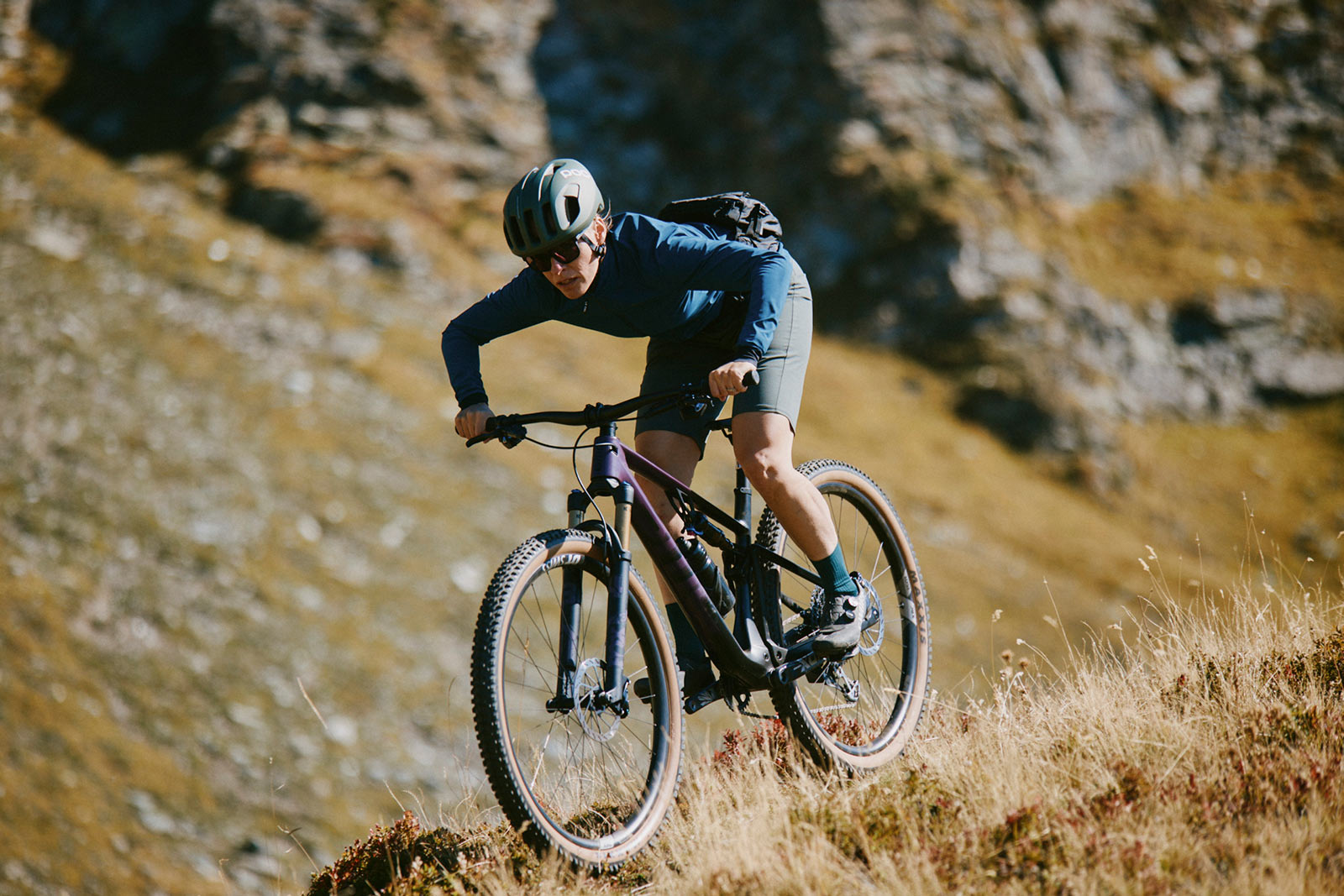
There was also the Fourstroke LT, which got wider bars, bigger tires, and different builds. It was meant for more aggressive riders, but kept the RAD dropper, which limited its utility as a proper “trail” bike. It had 120mm travel, but it got that from simply putting a longer stroke rear shock on there with a 120mm fork, which meant geometry wasn’t optimized for the longer travel.
The next generation expands and improves upon the lightweight, race-oriented intentions with fully modern XC race bikes and another truly unique integrated dropper seatpost…
2023 BMC Fourstroke 01
The new Fourstroke 01 is meant to reinvent the cross-country category with updated suspension kinematics, dual bottle cage mounts on the downtube, and … Autodrop, a dropper seatpost that will drop on its own, no need for you to sit on it.
There are a number of challenges with putting a dropper seatpost on an XC bike.
The first is weight. Racers want the lightest weight system possible, with some top pros even ignoring sponsor commitments to ride parts (like a dropper) that are lighter than what their sponsor may offer. By integrating the design into the frame, BMC can reduce the weight by 50-100g (or more) compared to a typical dropper.
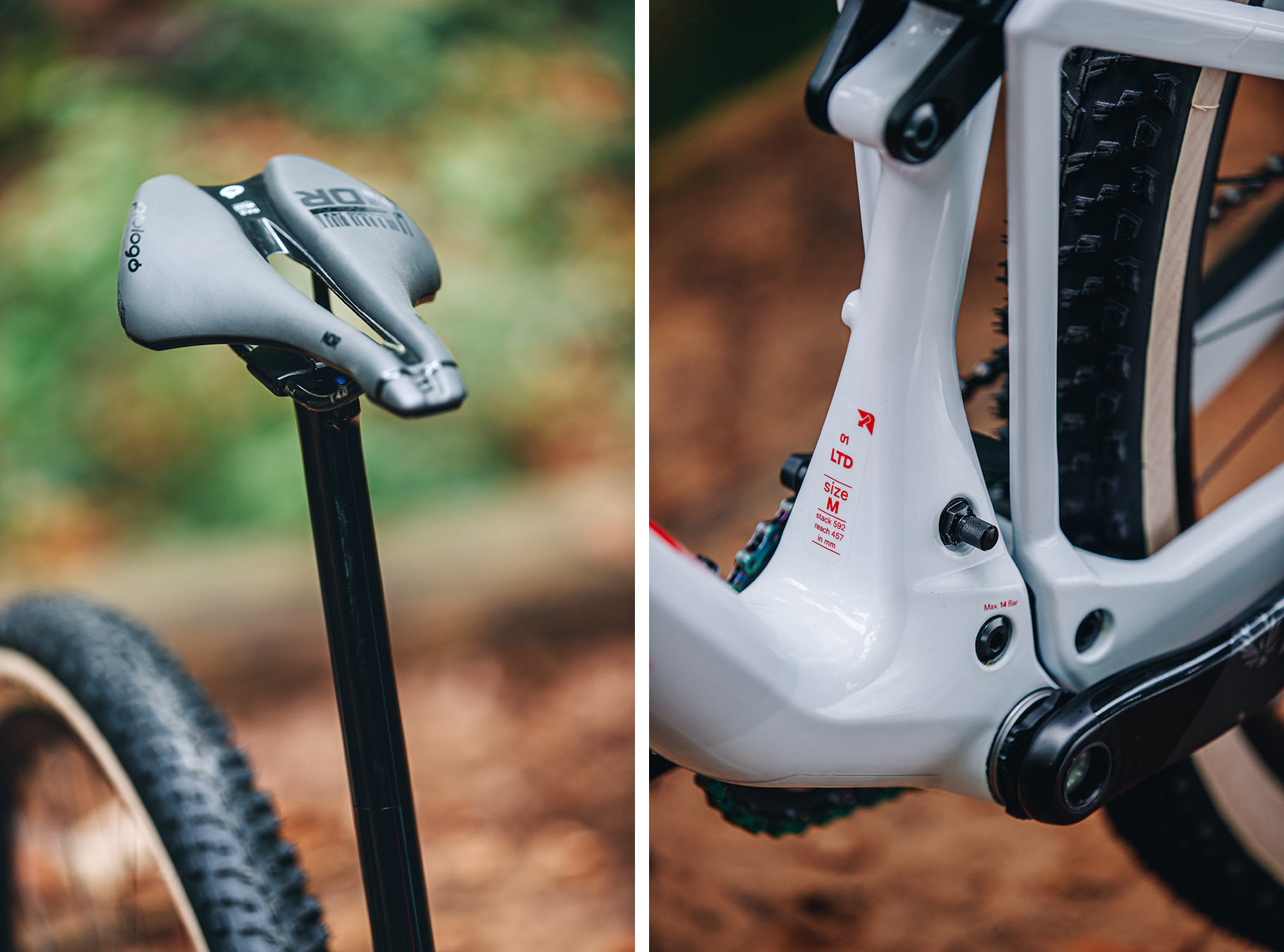
The weight savings come by using the frame as part of the post, but also by going with an ovalized shape. Besides preventing it from rotating, it also saves weight because they can reinforce it in the direction of the load, but save material elsewhere.
The other problem with droppers on XC bikes is that squatting to compress the post wastes energy. With modern courses and competitors pushing everyone to their absolute limit, using any amount of energy to adjust the bike is energy not being used to win.
Working with the athletes, like Titouan Carod, they found that racers would drop their post 70 to 100 times per race. That’s a lot of squatting. He said that not only does the Autodrop post save the legs that extra effort, it also lets them drop the post at the last minute, letting them pedal right up until it’s needed.
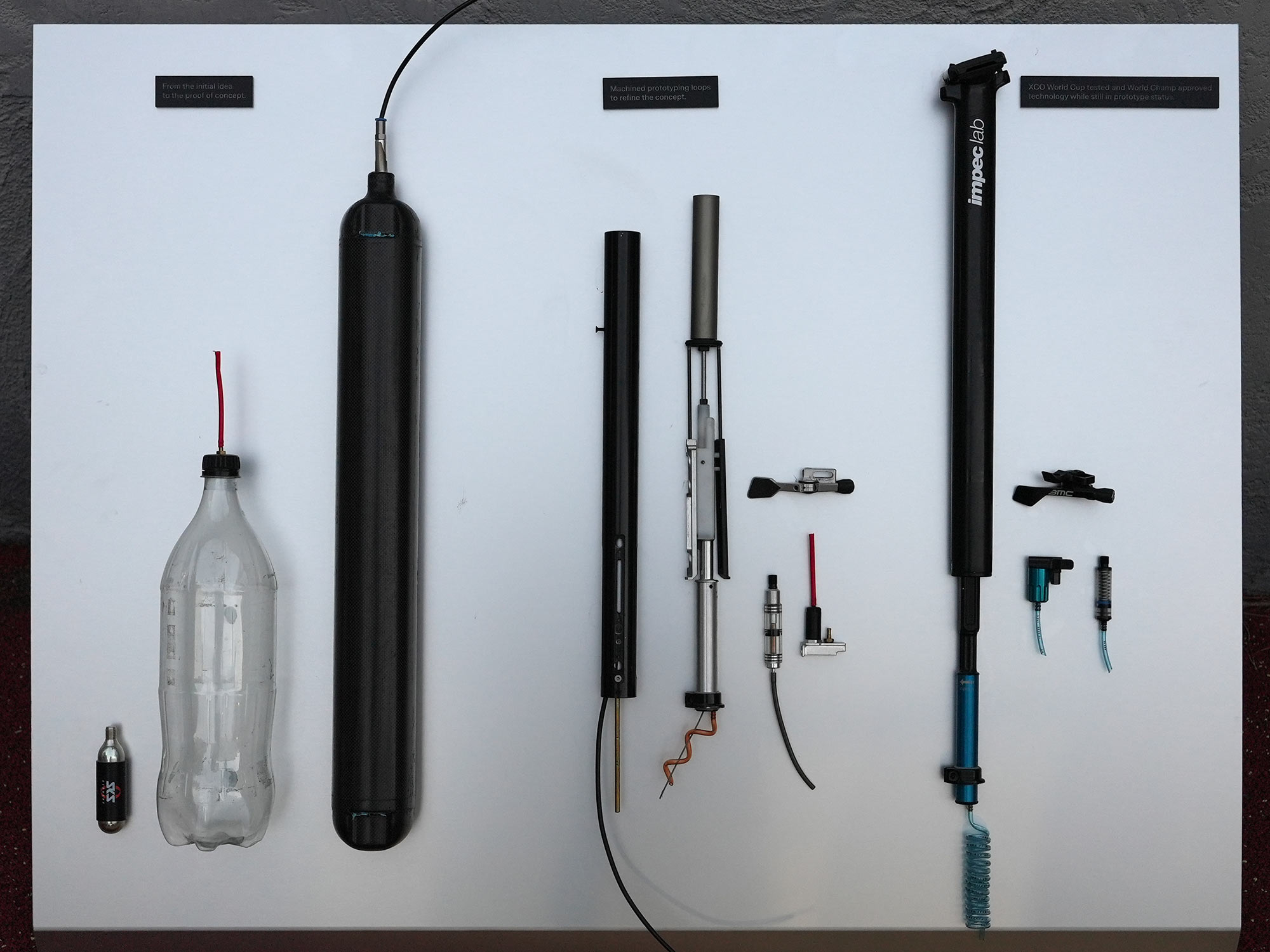
So BMC looked at other energy sources, and compressed air was the clear winner. It weighs nothing, and it works. The trick was getting it into a bike’s frame and making it work.
Their first test posts used a plastic soda bottle as the air chamber. Once that proved both reliable and functional, they worked on fitting it into the frame.
Unlike the old Shimano Airlines pneumatic shifting, BMC’s pneumatic system puts the air tank inside the frame. In fact, it’s a carbon fiber tank that’s co-molded as part of the downtube, saving weight. But yes, you’re essentially inflating your downtube.
The tank can be filled up to 14 Bar (~200psi), so, yes, you’ll want a good road or track floor pump that can go that high if you want to fill it all the way up), but there’s a pressure regulator to reduce it to 4 Bar (~58psi) to prevent it from damaging the dropper assembly. The post only needs 4 Bar to drop itself.
How does the Autodrop seatpost work? What if I run out of air pressure?
The first thing to know is this: It functions like a normal dropper post if you don’t pump up the Autodrop tank. Push the remote thumb lever and it releases so you can drop it by putting your weight on it. Press it again and a coil spring pushes the post up.
Or, pump up the tank and it’ll drop it for you if you push the remote lever just a bit further.
The system will work down to 4 Bar, and a fully inflated tank will give you about 100 drops. The air pressure is ONLY used to drop the post on its own. Basically, when you push the dropper lever all the way in, air fills a secondary chamber that presses against the coil spring to compress it, and the post drops.
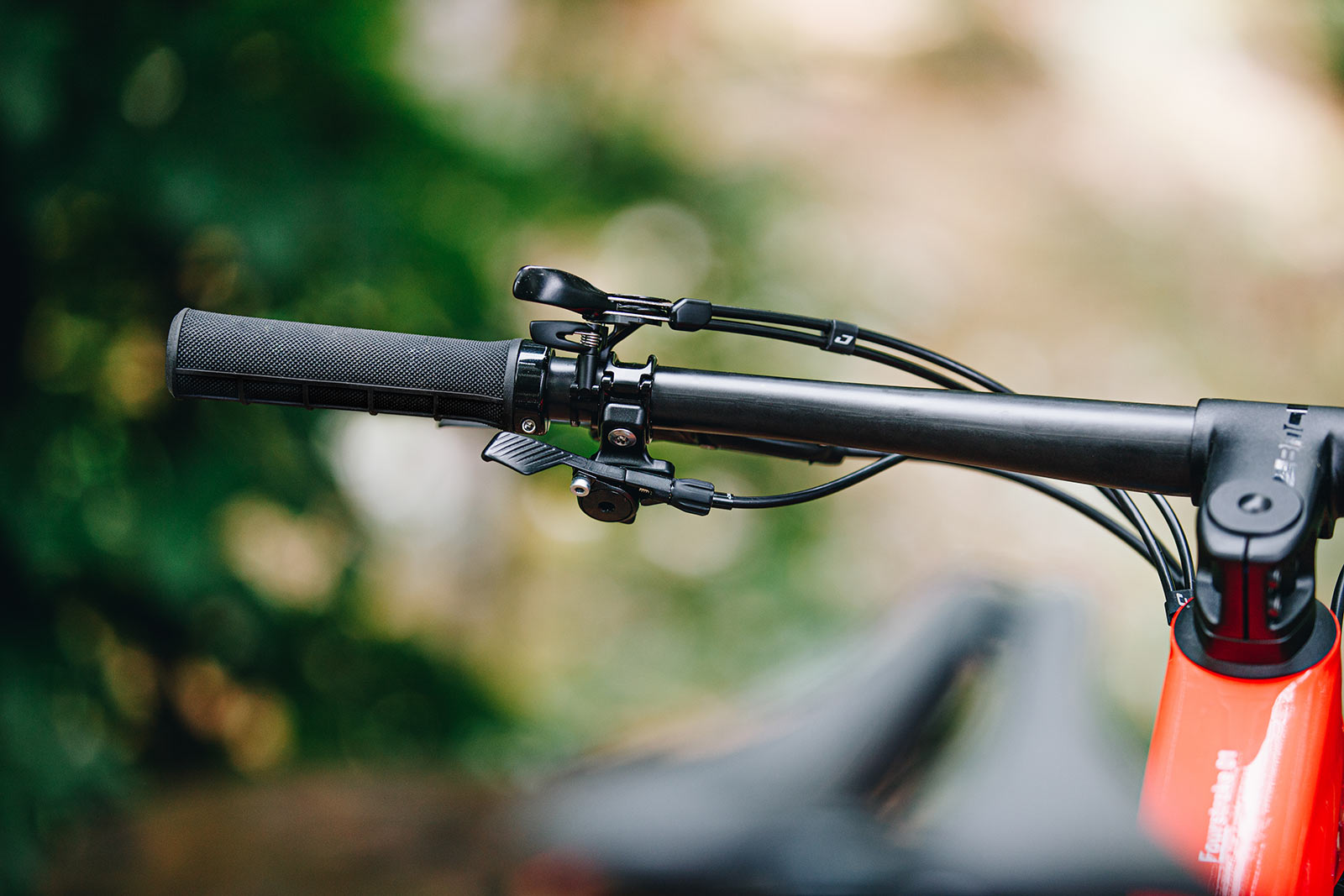
When you press the lever to raise the post, the air in that second chamber is released and the coil spring pops the post back to full height. It’s a two-position system – up, or down, no intermediate stops – and it has 80mm of travel, which they found was appropriate for XC bikes.
Yes, they could have given it more drop, but that would have used up more air per drop, so the decision was made to limit it to 80mm for all frame sizes. That also allows a large range of seat height adjustment, which is done with a single Allen bolt set lower on the seat tube.
And if you run out of air, the post will drop and raise like a normal dropper post, using your weight to drop it, and the coil spring to raise it.
Can I service it?
Yep. Just disconnect the air line by removing the rear wheel and pop out the mini mud flap, release the air pressure, unscrew the pressure reduction valve, pull it out, cut the tube (don’t worry, there’s a lot of extra tube, and they sell it as a spare part) and you can pull the entire seatpost out to clean and lubricate it.
Or just take it to your local shop and ask them to follow the simple 60+ step instructional video. But seriously, they say it’s not that complicated.
The whole thing only weighs about 350g, which is on par with some of the ultralight droppers out there, but none of those can do what Autodrop does.
Dialing in the Geometry
After building a test mule with adjustable geometry, BMC settled on a 1-degree slacker (66.5º) head angle and slightly longer reach.
The results were the expected longer, lower, slacker updates. But the biggest change is a dramatically lower BB drop of 53mm (9mm lower than before).
Their racers said the lower BB improved cornering on off-camber and flat sections and was worth the trade off of a few more pedal strikes here and there.
Updated Suspension Kinematics
For an XC bike, the Fourstroke’s recommended 30% sag is a lot, but it allows them to offer great small bump sensitivity.
The rest of the design is lighter than before, but they were able to do that while keeping a dual linkage design. Where many brands have gone to a linkage-driven single-pivot bike to save weight, BMC tested that against their APS dual linkage and the clock. Combining lap times and power meter data, they found that their APS was a better solution, being plenty efficient and faster overall.
Until now, BMC has used a vertical shock design, moving inline with the seat tube. But they wanted to give riders the option to run two bottles inside the front triangle. So, they engineered around a horizontal shock running under the top tube, which, typically, could allow some frame sizes to fit a small bottle on the seat tube.
BMC is a design-driven company, so not only do the bikes need to perform really well, they need to look good.
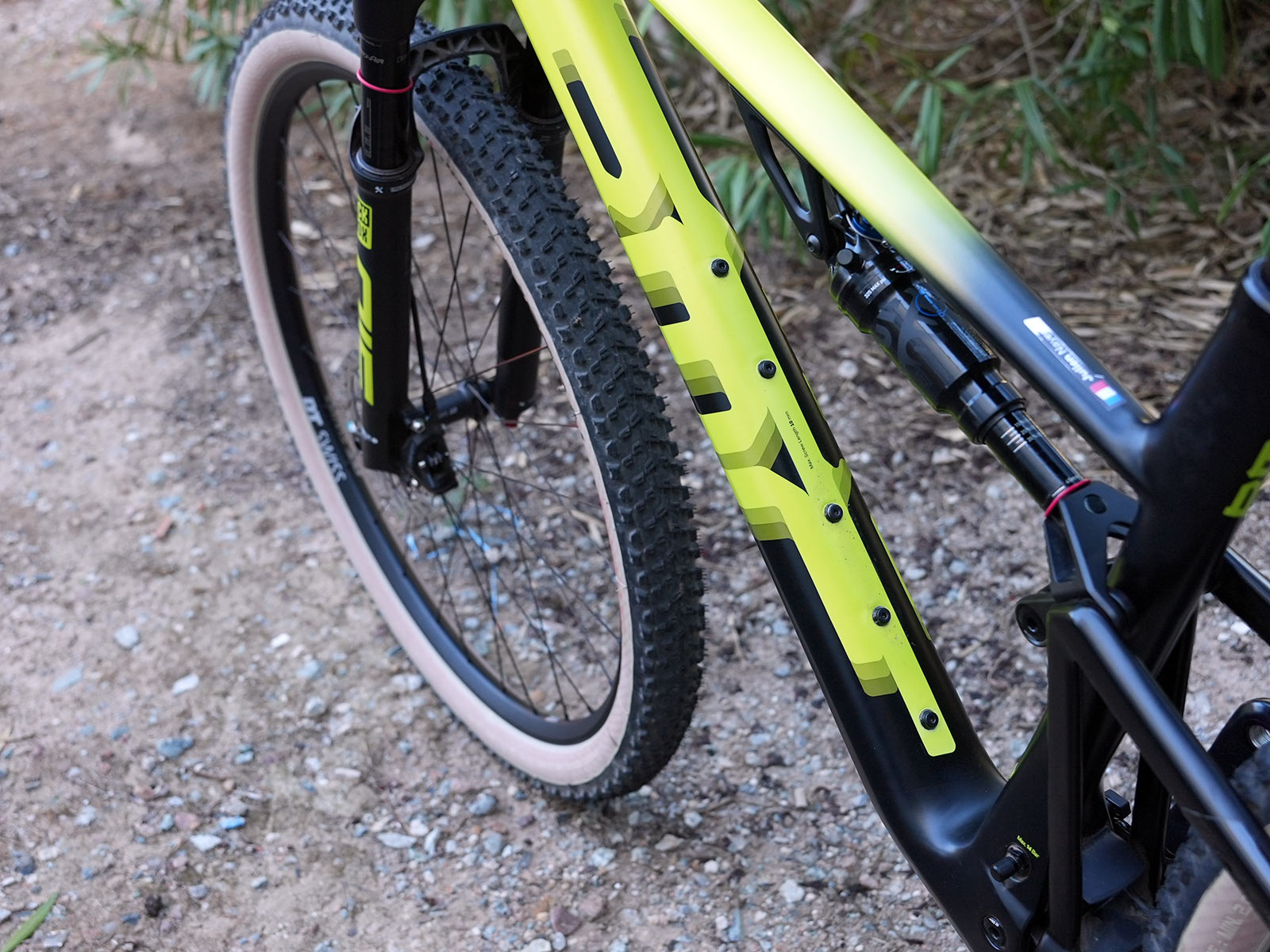
The new Fourstroke has a very low top tube and standover. And they wanted a nearly straight downtube, without creating a “belly” by having it jut out straight forward from the bottom bracket to add room.
Turns out, they were able to put five bottle bolts on the downtube to create room for two short bottle stacked inline. Or, since the lower mount has three bolts, you can run a larger bottle a little higher up to make it easier to reach.
The front shock mount is alloy, bolted under the top tube. This was intentional.
Rather than bonding it or molding it out of carbon, using a separate alloy part let them future proof it against different shock designs, which they say they’ve already taken advantage of during development. All they need to do is machine a new part to accommodate different shock volumes or lengths, and they say this is something you will appreciate soon because of things they know are coming but won’t tell us about yet.
The top tube flattens on the underside to make room for remote cable attachment points, adjustment levers, etc.
Making the Fourstroke more attainable
With the prior generation, the RAD seatpost added considerable cost, but was the only option. So, to make them more affordable, they had to really downgrade the spec.
With the 2023 Fourstroke, they have the 01 level with three models (plus a frameset) that get the integrated Autodrop seatpost, and a standard range that gets a standard round dropper seatpost with a lower level carbon fiber grade to give riders on a budget the same suspension and handling, but at more attainable price points. See full model and spec lists at bottom of this post.
2023 BMC Fourstroke LT
Take almost everything about the Fourstroke, tweak the upper APS linkages to add 20mm travel, give it slightly more aggressive spec, and you have the Fourstroke LT.
The LT, for “long travel”, has 120mm travel front and rear, but with geometry that’s 99% the same as the Fourstroke. And that’s because modern XC geo has gotten so aggressive, and many brands are pushing their XC race bikes to 120mm travel, so the LT is for that customer that wants quick handling with a bit more suspension.
Meaning, it’s XC geometry and XC-efficient suspension, with XC weights, but with a bit more travel. Think, marathons and epics and all day rides. Or, if you must, you could call it a fast “downcountry” bike.
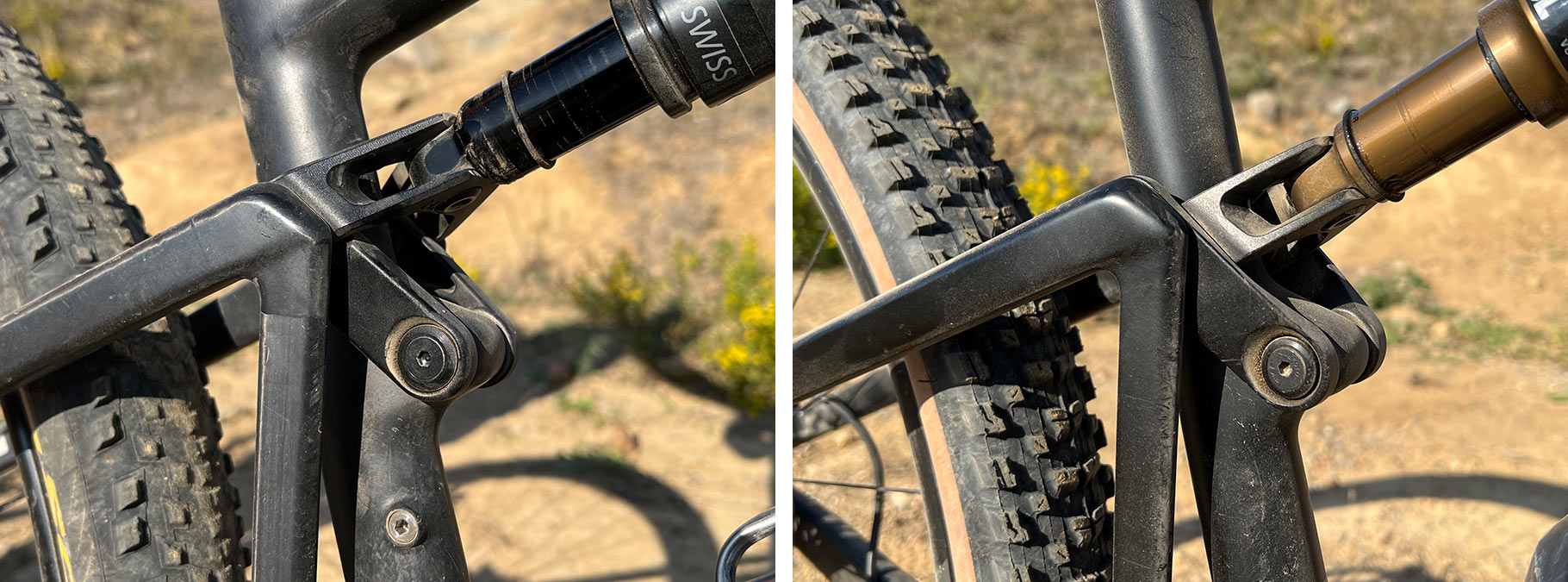
And they do that entirely with the upper linkage – the front and rear triangle are the same as the 100mm Fourstroke. The key difference in the geometry is that it has a 38mm BB drop, 15mm higher than the 100mm travel version, helping it handle the extra travel without taking the pedals too low. But they could keep the other angles identical, all by adjusting the position of the rear shock’s lower mount.
It doesn’t get the Autodrop dropper seatpost of the Fourstroke 01 models. And, unlike the prior model’s RAD seatpost, which was limited to 80mm drop, the new LT uses standard round dropper posts. Depending on frame size, you’ll get 125mm to 150mm of dropper travel.
Key spec differences & frame weight comparison
All of the bikes get 30mm internal width rims except for the Fourstroke 01 TWO, which has alloy rims with a 25mm internal width…to save weight on that model, all others are 30mm internal regardless of whether the rims are alloy or carbon.
The 100mm bikes come with 29×2.35″ tires, the LT gets 29×2.4” tires. The maximum recommended tire width on any model is 29×2.4″.
Other spec swaps for the LT include a low rise handlebar, angled stems, and 180mm brake rotors front and rear with four-piston brakes, and bigger forks – Rockshox SID 35mm and Fox 34 Stepcast, depending on the model.
By contrast, the 100mm bikes get SID SL or 32 Stepcast forks, flat handlebars, and 160mm rear/180mm front rotors on the front of the L/XL frame sizes, but 16omm front and rear on S/M sizes (saves weight), with 2-piston brake calipers.
Every 100mm Fourstroke model comes with dual remote lockouts for fork and shock, but the execution is different depending on spec. The Fox-equipped bikes get a DT Swiss three-position remote lever on top of the bar, above the dropper remote.
The Rockshox-equipped bikes get a much sleeker TwistLoc remote, a clear win for both aesthetics and ergonomics.
Claimed frame weight for the 01 frames is 2,172g, and claimed weight for the standard/LT frames is 2,130g. That’s with all hardware, but without rear shock or rear axle.
This means that the integral carbon fiber air tank built into the downtube with the pneumatic assembly only makes the 01-level frame 42g heavier. The result is a module weight with dropper seatpost that’s nearly the same between models, so you’re getting that advanced feature at no weight penalty.
2023 BMC Fourstroke Geometry, Models & Pricing
Full specs and details for all models are on BMC’s website. The Fourstroke 01 TWO will be the first available and is shipping now. Others will come out throughout the remainder of this year and even into Q2 2023…because supply chain issues.
Worth noting is the inclusion of Prologo and Fizik saddles across the range…no housebrand or generic logo’d saddles on any of the models at any price point. Vittoria tires are a nice touch on higher end models, too.
BMC Fourstroke 01 models
Fourstroke 01 LTD
Spec highlights:
- Fox Factory 32 Stepcast fork and Float DPS shock
- SRAM Eagle XX1 AXS
- SRAM Level Ultimate brakes
- DT Swiss XRC 1200 carbon wheels
- € 12,999.00 / CHF 13,499.00 / $13,499.00
This paint scheme is also available as a frameset with the same fork, shock, and the Autodrop system for €5,499.00 / CHF 5,999.00 / $5,999.00
Fourstroke 01 ONE
Spec highlights:
- Rockshox SID Ultimate & SIDLuxe Ultimate
- SRAM Eagle X01 AXS
- SRAM Level Ultimate brakes
- DT Swiss XRC 1501 carbon wheels
- €10,999.00 / CHF 11,499.00 / $11,499.00
Fourstroke 01 TWO
Spec highlights:
- Rockshox SID SL Select+ & SIDLuxe Select+
- SRAM Eagle GX AXS
- SRAM Level TLM brakes
- DT Swiss XR 1700 alloy wheels
- €8,999.00 / CHF 9,499.00 / $9,499.00
BMC Fourstroke models
Fourstroke ONE
Spec highlights:
- Rockshox SID SL Select+ & SIDLuxe Select+
- SRAM Eagle GX mechanical
- SRAM Level TLM brakes
- BikeYoke Divine dropper post
- DT Swiss XR 1700 alloy wheels
- €7,499.00 / CHF 7,999.00 / $7,999.00
Fourstroke TWO
Spec highlights:
- Fox 32 Stepcast Performance & Float DPS Performance
- Shimano XT 1×12
- Shimano XT brakes
- BikeYoke Divine dropper post
- DT Swiss XR 1700 alloy wheels
- €6,499.00 / CHF 6,999.00 / $6,999.00
Fourstroke THREE
Spec highlights:
- Rockshox SID SL Select RL & SIDLuxe Select+
- Shimano SLX 1×12
- Shimano SLX brakes
- X-Fusion Manic dropper post
- DT Swiss X 1900 alloy wheels
- €5,299.00 / CHF 5,799.00 / $5,799.00
Fourstroke FOUR
Spec highlights:
- Rockshox SID SL RL & SIDLuxe Select+
- Shimano Deore 1×12
- Shimano Deore brakes
- BMC rigid seatpost
- Shimano MT400-series hubs with SHL280S alloy rims
- €4,299.00 / CHF 4,699.00 / $4,699.00
BMC Fourstroke LT models
Fourstroke LT LTD
Spec highlights:
- Fox Float 34 SC Factory & Float DPS Factory
- SRAM X01 Eagle AXS
- SRAM G2 Ultimate brakes
- Rockshox Reverb AXS dropper post
- DT Swiss XRC 1501 carbon wheels
- €11,999.00 / CHF 12,499.00 / $12,499.00
Fourstroke LT ONE
Spec highlights:
- Rockshox SID Select+ & SIDLuxe Select+
- Shimano SLX 1×12
- Shimano SLX brakes
- BikeYoke Divine dropper post
- DT Swiss M 1900 alloy wheels
- €5,899.00 / CHF 6,299.00 / $6,299.00
Fourstroke LT TWO
Spec highlights:
- Rockshox SID RL & SIDLuxe Select+
- Shimano Deore/SLX 1×12
- Shimano BR-MT520 brakes
- X-Fusion Manic dropper post
- Alex MD30 alloy rims w/ Shimano MT400-series hubs
- €4,499.00 / CHF 4,999.00 / $4,999.00
Stay tuned for full ride and race reviews for the 01 and LT models soon!
